Peavey Electronics XR-AT Audio mixer power amplifier User Manual UserMan
Peavey Electronics Corporation Audio mixer power amplifier UserMan
UserMan
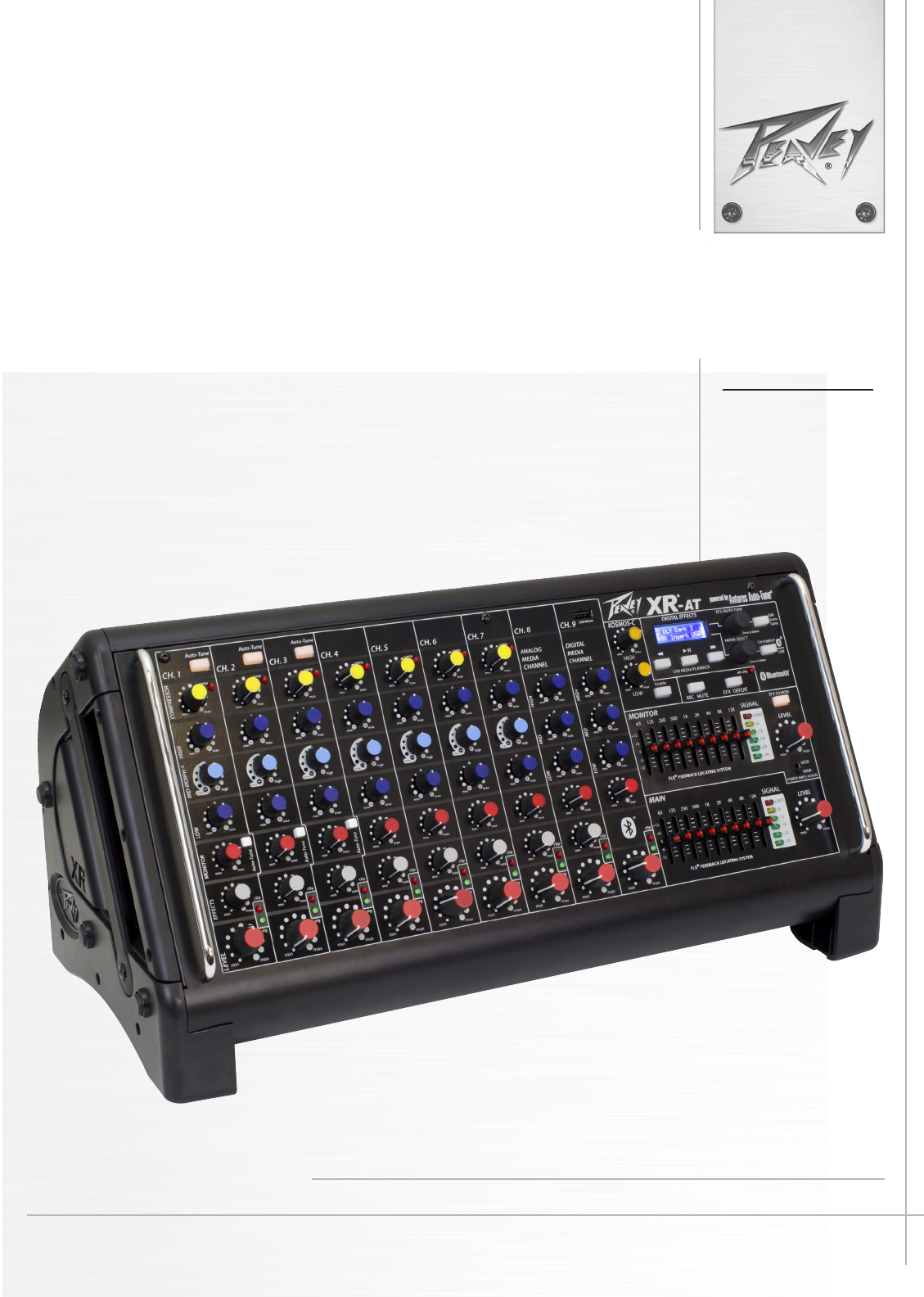
www.peavey.com
XR®-AT
Powered Mixer
Operating
Manual

FCC/ICESCompliancyStatement
ThisdevicecomplieswithPart15oftheFCCrulesandIndustryCanadalicense‐exemptRSSStandard(s).Operationis
subjecttothefollowingtwoconditions:(1)thisdevicemaynotcauseharmfulinterference,and(2)thisdevicemust
acceptanyinterferencereceived,thatmaycauseundesiredoperation.
LeprésentappareilestconformeauxCNRd’lndustrieCanadaapplicablesauxappareilsradioexemptsde
licence.L’exploitationestautoriséeauxdeuxconditionssuivantes:(1)I’appareilnedoitpasproduirede
brouillage,et(2)I’utilisateurdeI’appareildoitacceptertoutbrouillageradioélectriquesubi,mêmesile
brouillageestsusceptibled’encompromettrelefonctionnement.
Warning:ChangesormodificationstotheequipmentnotapprovedbyPeaveyElectronicsCorp.canvoidthe
user’sauthoritytousetheequipment.
Note–ThisequipmenthasbeentestedandfoundtocomplywiththelimitsforaClassBdigitaldevice,
pursuanttoPart15oftheFCCRules.Theselimitsaredesignedtoprovidereasonableprotectionagainst
harmfulinterferenceinaresidentialinstallation.Thisequipmentgenerates,uses,andcanradiateradio
frequencyenergyand,ifnotinstalledandusedinaccordancewiththeinstructions,maycauseharmful
interferencetoradiocommunications.However,thereisnoguaranteethatinterferencewillnotoccurina
particularinstallation.Ifthisequipmentdoescauseharmfulinterferencetoradioortelevisionreception,
whichcanbedeterminedbyturningtheequipmentoffandon,theuserisencouragedtotryandcorrectthe
interferencebyoneormoreofthefollowingmeasures.
Reorient or relocate the receiving antenna.
Increase the separation between the equipment and receiver.
Connect the equipment into an outlet on a circuit different from that to which the receiver is
connected.
Consult the dealer or an experienced radio/TV technician for help.
Caution
The equipment complies with FCC radiation exposure limits set forth for an uncontrolled
environment.
FCC Compliancy Statement
This device complies with Part 15 of the FCC rules. Operation is subject to the following two
conditions: (1) this device may not cause harmful interference, and (2) this device must accept any
interference received, that may cause undesired operation.
Warning: Changes or modications to the equipment not approved by Peavey Electronics Corp. can
void the user’s authority to use the equipment.
Note - This equipment has been tested and found to comply with the limits for a Class B digital device,
pursuant to Part 15 of the FCC Rules. These limits are designed to provide reasonable protection
against harmful interference in a residential installation. This equipment generates, uses and can radiate
radio frequency energy and, if not installed and used in accordance with the instructions, may cause
harmful interference to radio communications. However, there is no guarantee that interference will not
occur in a particular installation. If this equipment does cause harmful interference to radio or television
reception, which can be determined by turning the equipment off and on, the user is encouraged to try
and correct the interference by one or more of the following measures.
• Reorient or relocate the receiving antenna.
• Increase the separation between the equipment and receiver.
• Connect the equipment into an outlet on a circuit different from that to which the receiver is
connected.
• Consult the dealer or an experienced radio/TV technician for help.
Peavey Electronics Corporation • 5022 Hartley Peavey Drive • Meridian, MS • 39305
(601) 483-5365 • FAX (601) 486-1278 • www.peavey.com • 80305780 • ©2011

ENGLISH
XR®- AT
Powered Mixer
Congratulations on the purchase of your new XR® -AT powered mixer from Peavey®. The Peavey XR-AT is a revolutionary all-in-one
powered mixer that provides everything a musician or DJ needs, including up to eight combination XLR and 1/4" inputs using
Peavey’s award winning mic preamps and dual 500 Watt amplifiers for crystal clear audio reproduction. Plus, for the first time ever,
the XR-AT mixer includes Antares® Auto-Tune® pitch correction technology. This technology can literally help anyone sing in key
and is used on professional recordings and live performances throughout the world.
The Peavey XR-AT uses exclusive features like Midmorph® to accurately improve tone and clarity of vocals. Feedback is quickly
and easily identified and removed with Peavey’s dual 9-band graphic EQ’s combined with our patented and revolutionary FLS®
Feedback Locating System. The XR-AT is equipped with Peavey’s exclusive Kosmos®-C technology, which drastically enhances the
low end of the audio spectrum. Built-in 24-bit digital effects complement the already feature-packed unit.
Before you begin using your powered mixer it is very important to ensure that the product has the proper AC voltage
supplied. You can find the proper voltage for your amp printed next to the IEC line (power) cord on the rear panel of the unit.
Features:
• FLS® Feedback Locating System
• Midmorph® EQ
• Kosmos®-C
• On-board 24-bit digital effects with mute button
• Digital effects parameter control
• Combination XLR and 1/4" input jacks
• Dual 9-band graphic EQ with FLS®
• Master mic mute
• Footswitchable Effects Defeat
• Global 48 volt phantom power
• RCA, 3.5mm media Inputs
• Bluetooth® streaming
• USB Audio playback
• Selectable main or monitor dual power amp
• RCA record outputs
• LED meter bridge
• Power amp sub-sonic filter
• Clip and signal present indicators
• Main and monitor 1/4" line level outputs
• DDT™ speaker protection circuit
• Three channels of Antares® Auto-Tune® pitch correction
VENTILATION: For proper ventilation, allow 6" (15.5 cm) clearance on all sides.
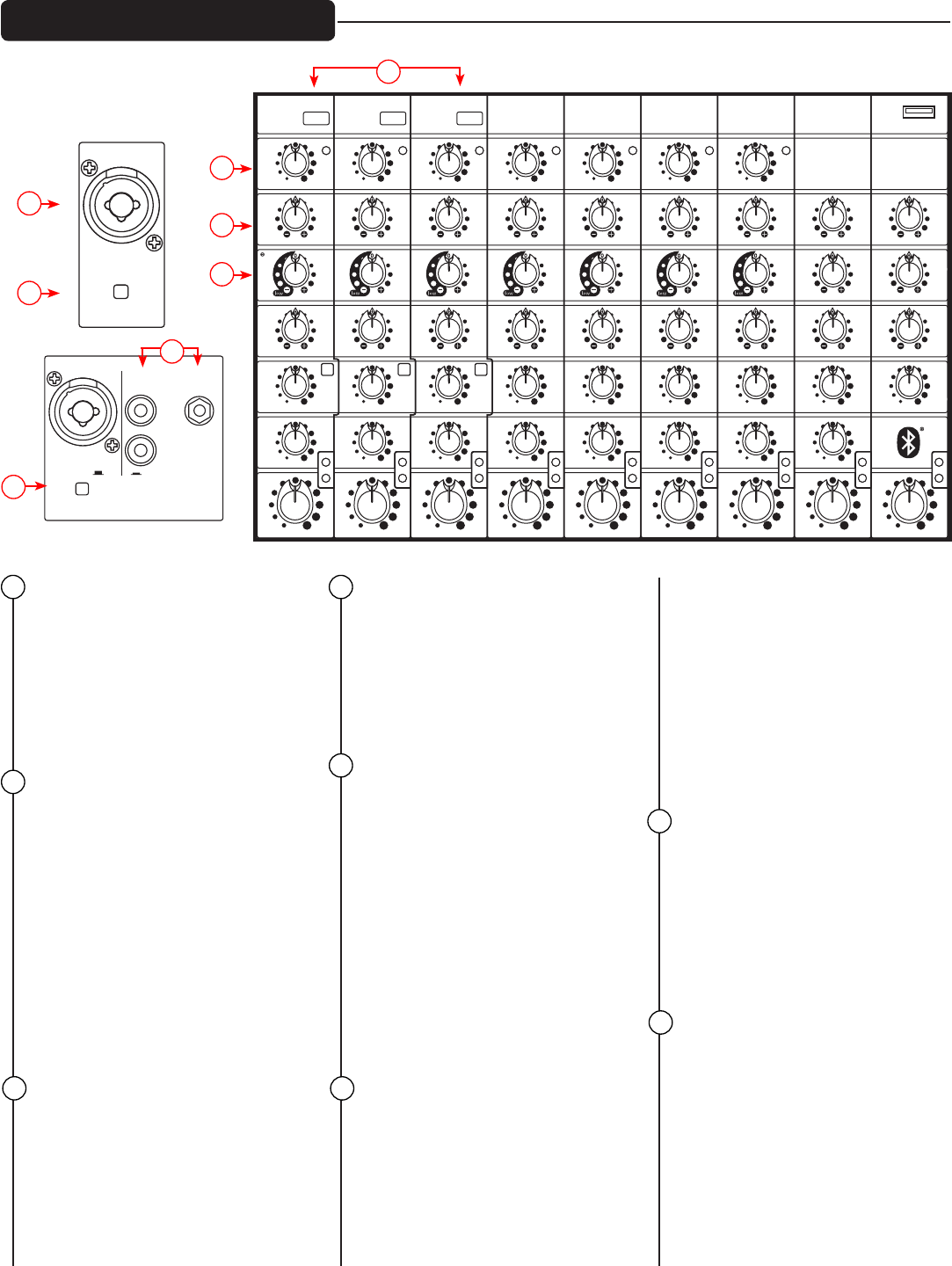
MIC/LINE INPUT (CH.1-8)
This combination input jack can
accept either a 1/4" (balanced
or unbalanced) input or an
XLR balanced, low-impedance
connection. The tip is positive on
the 1/4" balanced input, and pin 2
is positive on the XLR
PAD (CH. 1-7)
When engaged, the pad reduces
the input signal by 25dB. If you
notice distortion from a particular
channel or if the channel becomes
loud very quickly, try engaging
this switch. In addition to
increasing the dynamic range, the
channel can now accommodate a
higher input level before clipping
occurs, which may be helpful
when close-mic’ing a loud guitar
amp or drum kit, for example.
MEDIA INPUTS (CH.8 RCA and
3.5mm)
These inputs, both RCA and
3.5mm jacks accept a stereo input
from the output of an MP3 Player,
CD player, tape deck or other
similar device.
INPUT SELECT SWITCH (CH. 8)
This switch allows the user to
select the input signal being sent
to channel 8. In the “up” position,
the Mic-Line preamp is active. In
the “down” position, the RCA-
3.5mm media inputs are active.
AUTO-TUNE ON/OFF (CH 1-3)
Each of the first three channels of
the XR-AT can be routed through
the world famous Auto-Tune®
processing for automatic pitch
correction. These three backlit
switches indicate the status of the
Auto-Tune in each channel. They
also allow the Auto-Tune process
to be bypassed with the push of
a button. When the switch is lit,
Auto-Tune is active. When it is
dark, the Auto-Tune process is
bypassed.
COMPRESSOR AND COMP LED
(CH 1-7)
This knob adjusts the amount
of compression applied to the
channel. As the knob is turned to
the right, the mixer automatically
raises the compression ratio
while adjusting the output gain
accordingly. The result is a
narrower, more even dynamic
range, as louder signals are
softened while the overall level
is boosted. Avoid setting the
knob too high, however, as
excess compression may lead
to feedback. The LED will light
red when the signal level is
high enough to activate the
compression.
HIGH EQ
This High EQ shelving type of
active tone control varies the
treble frequencies (+/- 15 dB at
12kHz) and is designed to remove
noise or add brilliance to the
signal, depending on the quality
of the source.
MID-MORPH EQ (CH. 1-7)
Where most mid-range controls
work at just one frequency, the
Mid-Morph® works at two. When
turned counterclockwise, it cuts at
250Hz to reduce frequencies that
muddy the sound. When turned
clockwise, it boosts at 4kHz to
add intelligibility to vocals. Either
way, improved vocal or instrument
definition can be achieved.
1 4
2
5
7
36
8
Channel Controls
PAD
1
PAD
2
PAD
3
PAD
4
PAD
5
PAD
6
PAD
7 8
L
R
MEDIA
INPUTS
RCA 3.5mm
TRS
SUB OUT
TRS BAL
TRS BAL
MAIN OUT
TRS BAL
MONITOR OUT
NON-POWERED OUTPUTS
L
R
RECORD OUT
UNBAL
AMP 2
AMP 1
POWER AMP IN
ENABLE
ACTIVE
GLOBAL
PHANTOM
POWER
INPUT SELECT
MEDIAXLR-1/4”
PAD
1
PAD
2
PAD
3
PAD
4
PAD
5
PAD
6
PAD
7
8
L
R
MEDIA
INPUTS
RCA 3.5mm
TRS
SUB OUT
TRS BAL
TRS BAL
MAIN OUT
TRS BAL
MONITOR OUT
NON-POWERED OUTPUTS
L
R
RECORD OUT
UNBAL
AMP 2
AMP 1
POWER AMP IN
ENABLE
ACTIVE
GLOBAL
PHANTOM
POWER
INPUT SELECT
MEDIAXLR-1/4”
comp
Auto-Tune
HIGHMID-MORPHLOW
LOW MID HIGH
LOW MID HIGH
MONITOREFFECTS COMPRESSOR
CH. 1
LEVEL
min max
min max
min max
min max
min max
comp
Auto-Tune
CH. 2
min max
min max
min max
min max
min max
high
min max
clip
sig
clip
sig
comp
Auto-Tune
CH. 3
min max
min max
min max
min max
min max
high
min max
clip
sig
comp
CH. 4
min max
min max
min max
min max
min max
high
min max
clip
sig
comp
CH. 5
min max
min max
min max
min max
min max
high
min max
clip
sig
comp
CH. 6
min max
min max
min max
min max
min max
high
min max
clip
sig
comp
CH. 7
min max
min max
min max
min max
min max
high
min max
clip
sig
CH. 8
min max
min max
min max
min max
min max
clip
sig
CH. 9
min max
min max min max
min max
min max
min max
clip
sig
LEVEL
MAIN
min max
+12
+6
0
-6
-12
63 125 250 500 1K 2K 4K 8K 12K
FLS FEEDBACK LOCATING SYSTEM
min max
high
LEVEL
MONITOR
min max
+12
+6
0
-6
-12
63 125 250 500 1K 2K 4K 8K 12K
FLS FEEDBACK LOCATING SYSTEM
SIGNAL
MON
MAIN
POWER AMP2 ASSIGN
EFX TO MON
Enable
KOSMOS-C
min max
min max
USB
MIC
LOW
HIGH
EFX
Edit
Auto-
Tune
Press to Select
Press to Select
efx clip
EFX / AUTO-TUNE
MEDIA SELECT
CH 9 INPUT
USB MEDIA PLAYBACK
DIGITAL EFFECTS
MUTE DEFEAT
ANALOG
MEDIA
CHANNEL
DIGITAL
MEDIA
CHANNEL
USB MEDIA
-6
-12
LIMIT
-18
-24
-30
SIGNAL
-6
-12
LIMIT
-18
-24
-30
Auto-Tune
Auto-Tune
Auto-Tune
1
6
7
8
2
4
5
3
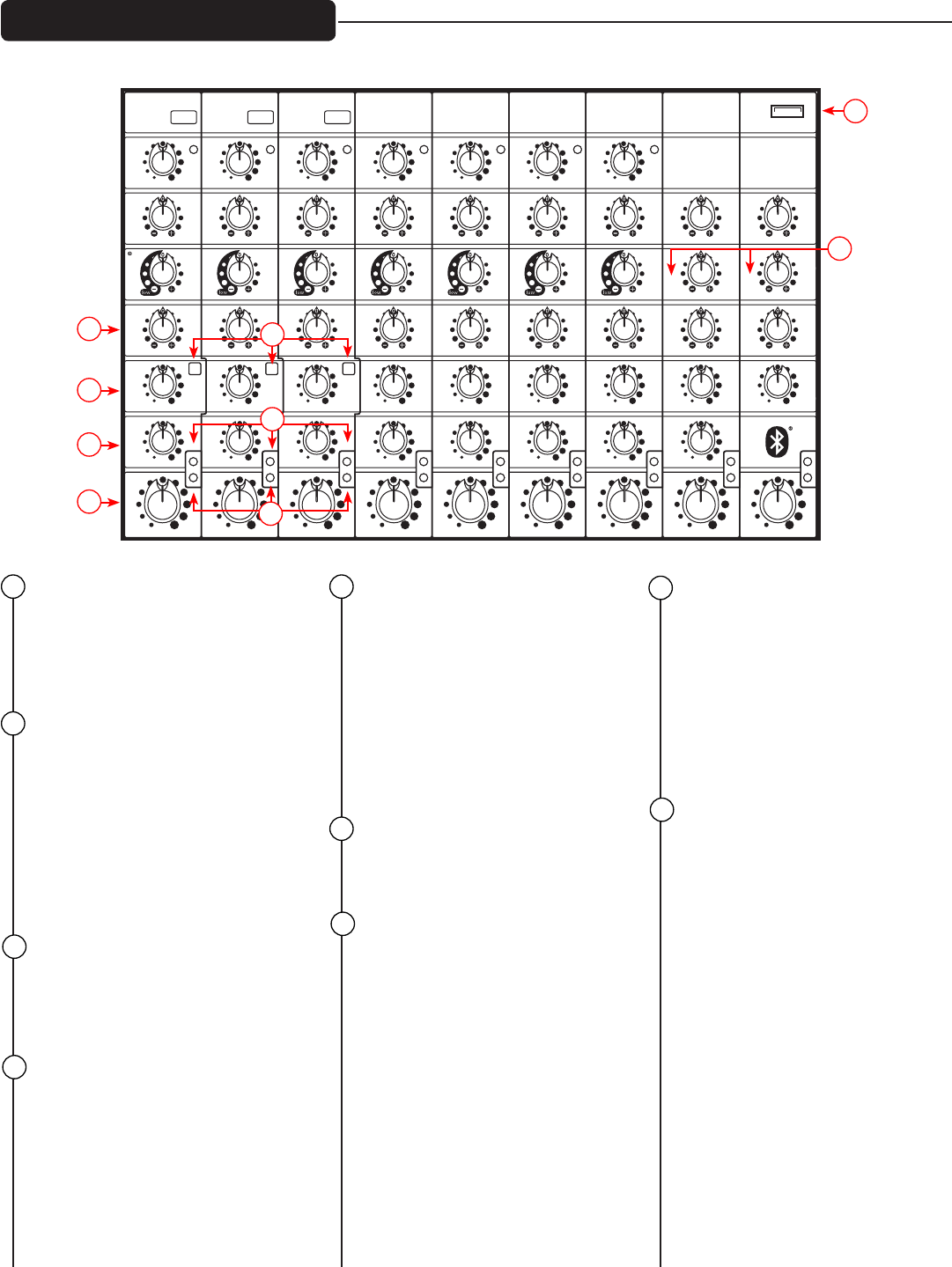
Channel Controls
MID EQ (CH. 8 & 9)
The mid EQ is a band-pass
(peak/notch) type of active tone
control that varies the mid-range
frequencies (+/-15dB at 450Hz).
LOW EQ
A shelving type of EQ that varies
the bass frequency levels (+/- 15dB
at 80Hz). Low EQ adds depth to
thin-sounding signals or cleans up
the muddy ones. As with any EQ,
use sparingly. Too much of this EQ
can give you a booming bottom
end.
MONITOR SEND
The monitor send adjusts the level
of the channel signal added to the
monitor mix.
AUTO-TUNE TO MONITOR BUTTON
(CH. 1-3)
This allows the user to select
whether to send the dry signal
or the Auto-Tuned signal to the
monitors in the Auto-Tune® capable
channels.
EFFECTS SEND (CH. 1-8)
This control adjusts the level of the
channel signal added to the effects
mix. The signal is sent to the
internal effects processor. Turning
the knob to the left (0) will turn
off the effects on the associated
channel, while turning the knob to
the right will increase the amount
of the selected effect.
LEVEL
This control sets the signal level
sent to the main mix.
CLIP
When this LED turns on or blinks
red, it is an indication that the
signal in the channel is potentially
too strong and could cause
distortion. Turn down the Level
control (14) until the Clip light is no
longer present. If you are having
difficulty getting a clean signal, try
varying the output of the connected
device, if possible.
SIG
When this LED is green, it is an
indication the mixer is receiving
signal at the input of the channel.
If you are having trouble getting
sound out of the mixer and this LED
is not on, check the microphone,
instrument or cable that is
connected to the channel.
USB MEDIA JACK (CH. 9)
A-type USB connector to which a
removable data storage device can
be connected to play back music.
9 13
10
14
16
11
12
15
17
comp
Auto-Tune
HIGHMID-MORPHLOW
LOW MID HIGH
LOW MID HIGH
MONITOREFFECTS COMPRESSOR
CH. 1
LEVEL
min max
min max
min max
min max
min max
comp
Auto-Tune
CH. 2
min max
min max
min max
min max
min max
high
min max
clip
sig
clip
sig
comp
Auto-Tune
CH. 3
min max
min max
min max
min max
min max
high
min max
clip
sig
comp
CH. 4
min max
min max
min max
min max
min max
high
min max
clip
sig
comp
CH. 5
min max
min max
min max
min max
min max
high
min max
clip
sig
comp
CH. 6
min max
min max
min max
min max
min max
high
min max
clip
sig
comp
CH. 7
min max
min max
min max
min max
min max
high
min max
clip
sig
CH. 8
min max
min max
min max
min max
min max
clip
sig
CH. 9
min max
min max min max
min max
min max
min max
clip
sig
LEVEL
MAIN
min max
+12
+6
0
-6
-12
63 125 250 500 1K 2K 4K 8K 12K
FLS FEEDBACK LOCATING SYSTEM
min max
high
LEVEL
MONITOR
min max
+12
+6
0
-6
-12
63 125 250 500 1K 2K 4K 8K 12K
FLS FEEDBACK LOCATING SYSTEM
SIGNAL
MON
MAIN
POWER AMP2 ASSIGN
EFX TO MON
Enable
KOSMOS-C
min max
min max
USB
MIC
LOW
HIGH
EFX
Edit
Auto-
Tune
Press to Select
Press to Select
efx clip
EFX / AUTO-TUNE
MEDIA SELECT
CH 9 INPUT
USB MEDIA PLAYBACK
DIGITAL EFFECTS
MUTE DEFEAT
ANALOG
MEDIA
CHANNEL
DIGITAL
MEDIA
CHANNEL
USB MEDIA
-6
-12
LIMIT
-18
-24
-30
SIGNAL
-6
-12
LIMIT
-18
-24
-30
Auto-Tune
Auto-Tune
Auto-Tune
10
11
13
14
17
12
15
16
9
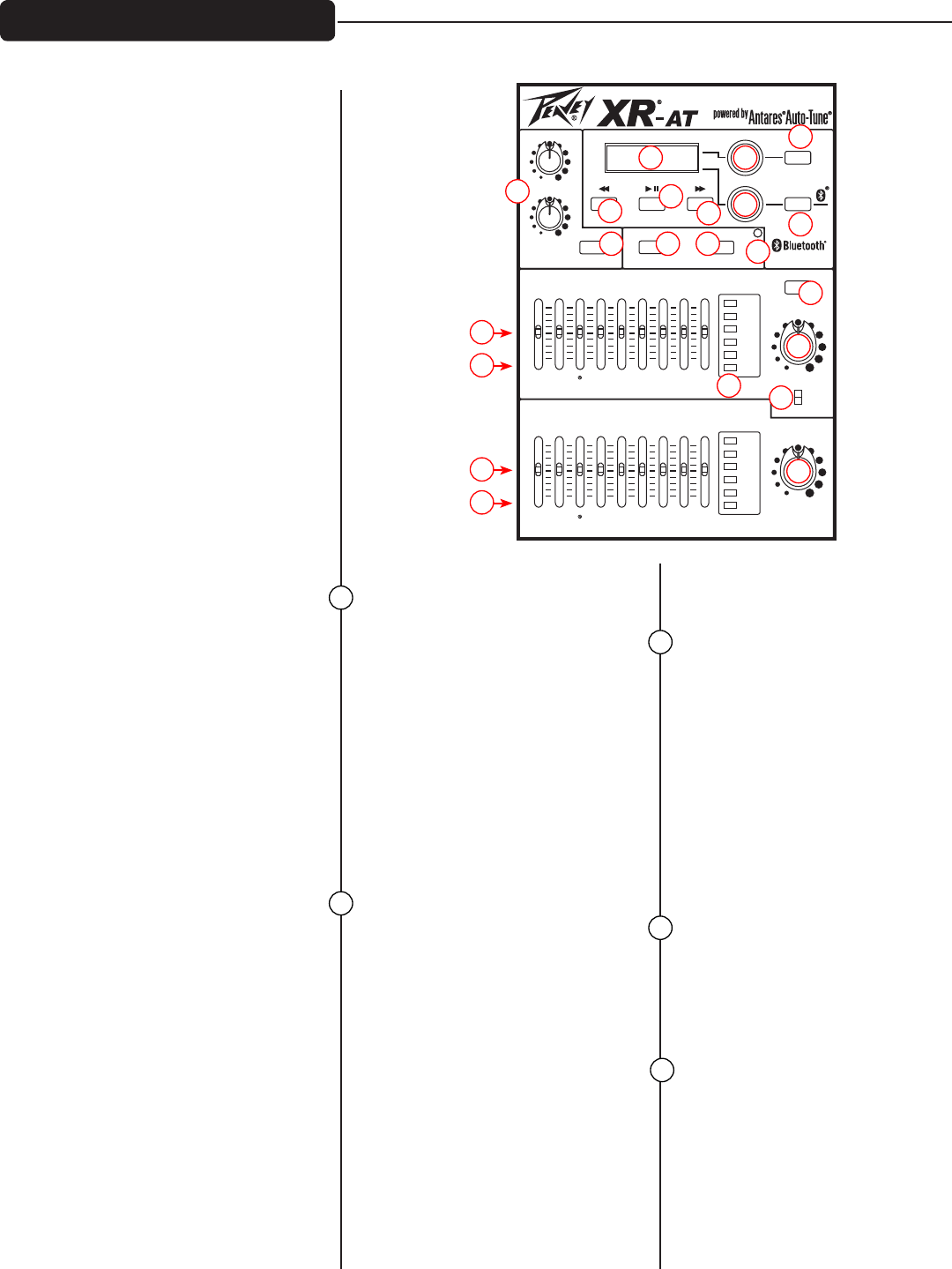
USB PLAYBACK:
First, make sure channel 9 is in
USB playback mode by checking
the status of the Ch 9 INPUT button
(37). When the switch is dark,
channel 9 is in USB playback mode.
If it is blinking or solid blue, it is in
Bluetooth mode. The bottom of the
LCD display will say “Insert USB
Drive” when in USB playback mode.
Insert your USB drive in the USB
Media Jack (17) at the top of
channel 9. The mixer will now go
into folder navigation mode.
In folder navigation mode, you can
navigate through all of the folders
present in the USB drive. The
first folder in the list will always
be “<ROOT>”. This is the root
directory of the USB drive and will
contain any songs that are not in
a specific folder. To navigate, use
the “Media Select” encoder (36).
To select a folder, press the “Media
Select” encoder. Once you select
a folder, the mixer will enter song
navigation mode and will display all
of the playable songs in that folder.
In song navigation mode, you
can select a song by turning and
pressing the “Media Select”
encoder or by pressing the “Next”
and “Previous” switches. If you
were currently playing a song and
selected a new song, the mixer
will automatically start playing the
new song. If you were paused or
stopped, the mixer will select the
new song and remain stopped.
To fast forward a song, press and
hold the “Next” switch, and to
rewind a song, press and hold the
“Previous” switch.
To go back to folder navigation
mode, scroll all the way to the left
and there will be an option called
“<FOLDERS>”. Selecting this
item will enter folder navigation
mode, where you can select
another folder of songs.
If a folder is selected that has no
playable songs, “No Songs” will be
displayed on the LCD. Scroll to the
left and select “<FOLDERS>” to
go back to folder navigation mode
and select another folder.
MASTER CONTROLS
FLS
When feedback occurs, the
corresponding LED of the frequency
that is closest to the frequency that
is feeding back will illuminate the
slider to be adjusted. Slowly bring
the corresponding slider down
until feedback is gone. The LED
will remain illuminated for a few
seconds after the feedback is gone.
If the feedback doesn’t return, all
of the LEDs will become active
again.
GRAPHIC EQ
These nine-band Equalizers are
designed to either be used to
reduce feedback or to adjust the
overall frequency response of the
signal being sent to the amplifiers.
Subtle adjustments made with
the graphic equalizer can improve
the way your loudspeaker
system sounds in the room. You
should be aware however, that
setting large amounts of boost
or arbitrary curves can reduce
amplifier headroom, leading to
early distortion or just plain bad or
unintelligible sound. Working with
the FLS, the graphic EQ can also
be used to reduce feedback. Each
band of EQ can supply up to 12dB
of boost or cut.
LEVEL LED LADDER
These LEDs indicate the signal level
of the main mix and the monitor
mix. The top LED indicates LIMIT
and activation of our revolutionary
DDT speaker protection circuit.
Peavey’s award winning speaker
protection is built into the XR-AT
powered mixer and is activated
automatically to maximize the
power amplifier without fear of
distortion.
MAIN LEVEL
The Main level control sets the
level of the main mix and the
overall volume of the powered
mixer.
MONITOR LEVEL
The Monitor level control adjusts
the level of the signal coming out
of the Monitor send 1/4" jack (41).
It can also be assigned to feed
the 2nd power amplifier via the
selector switch (24).
Master Controls
18
19
20
21
comp
Auto-Tune
HIGHMID-MORPHLOW
LOW MID HIGH
LOW MID HIGH
MONITOREFFECTS COMPRESSOR
CH. 1
LEVEL
min max
min max
min max
min max
min max
comp
Auto-Tune
CH. 2
min max
min max
min max
min max
min max
high
min max
clip
sig
clip
sig
comp
Auto-Tune
CH. 3
min max
min max
min max
min max
min max
high
min max
clip
sig
comp
CH. 4
min max
min max
min max
min max
min max
high
min max
clip
sig
comp
CH. 5
min max
min max
min max
min max
min max
high
min max
clip
sig
comp
CH. 6
min max
min max
min max
min max
min max
high
min max
clip
sig
comp
CH. 7
min max
min max
min max
min max
min max
high
min max
clip
sig
CH. 8
min max
min max
min max
min max
min max
clip
sig
CH. 9
min max
min max min max
min max
min max
min max
clip
sig
LEVEL
MAIN
min max
+12
+6
0
-6
-12
63 125 250 500 1K 2K 4K 8K 12K
FLS FEEDBACK LOCATING SYSTEM
min max
high
LEVEL
MONITOR
min max
+12
+6
0
-6
-12
63 125 250 500 1K 2K 4K 8K 12K
FLS FEEDBACK LOCATING SYSTEM
SIGNAL
MON
MAIN
POWER AMP2 ASSIGN
EFX TO MON
Enable
KOSMOS-C
min max
min max
USB
MIC
LOW
HIGH
EFX
Edit
Auto-
Tune
Press to Select
Press to Select
efx clip
EFX / AUTO-TUNE
MEDIA SELECT
CH 9 INPUT
USB MEDIA PLAYBACK
DIGITAL EFFECTS
MUTE DEFEAT
ANALOG
MEDIA
CHANNEL
DIGITAL
MEDIA
CHANNEL
USB MEDIA
-6
-12
LIMIT
-18
-24
-30
SIGNAL
-6
-12
LIMIT
-18
-24
-30
Auto-Tune
Auto-Tune
Auto-Tune
18
18
19
19
35
3430
36
282726
31
32
33
25
29
37
23
22
20
24
21
22
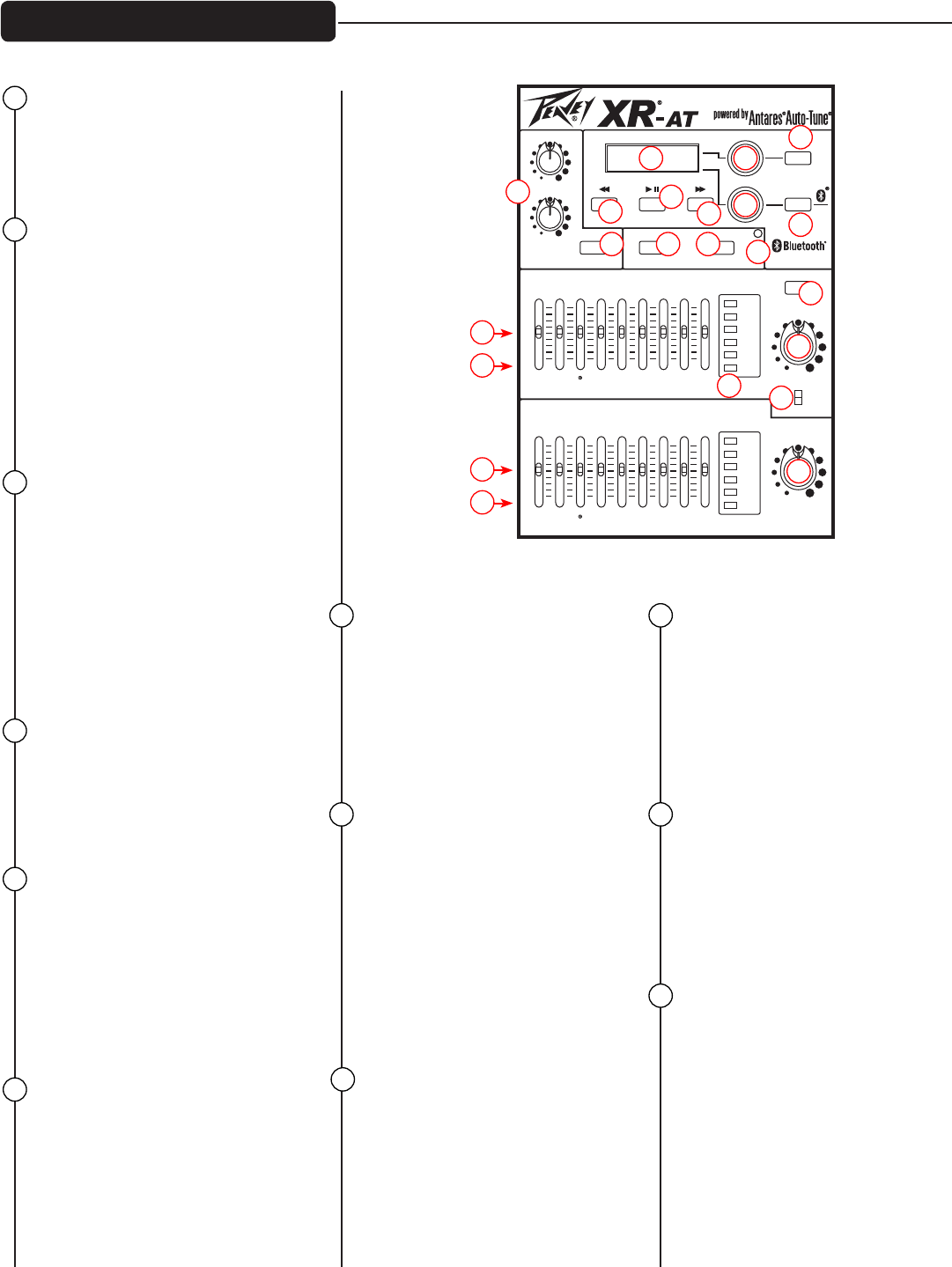
EFX TO MON
This switch toggles the EFX return
signal being sent to the monitors.
When it is lit, the effects signal is
being sent to the monitors.
POWER AMP 2 ASSIGN
This switch allows the user to
select the signal that is assigned
to power amp 2 (49). The user can
elect to send either the Main mix
signal or the Monitor mix signal
to the second internal power
amplifier. This allows the user to
run both power amps for mains
or use power amp 1 for mains and
power amp 2 for monitors.
KOSMOS-C
The Kosmos®-C uses special
circuitry to enrich the sound of your
system. This is not just a simple
bass boost. It provides “natural
bass enhancement” by adding
harmonically related bass signals
that track the envelope of the
original signal. The Kosmos-C high
control can be used to add clarity
to dull signals.
KOSMOS ENABLE
When lit, the Kosmos enhanced
signal is added to the main mix.
This allows you to compare the
enhanced signal with the dry with
the press of a button.
MIC MUTE
Depressing this button mutes the
mic/line inputs in all 8 channels.
The media input jacks (RCA and
3.5mm) on channel 8 and the
USB/BT inputs on channel 9 are
still “live”. This allows you to play
break music, while muting all of the
microphone inputs.
EFX DEFEAT
This button mutes the effects being
sent to the main mix, allowing the
user to listen to a dry signal at the
main outputs. When muted, the
switch will be red. This can also
be activated with a momentary
footswitch. See (50).
EFX CLIP
This LED blinks red when the signal
being sent to the effects section is
too high and is causing distortion.
Find the source of the hot signal by
reducing the EFX send (13) on each
channel until the LED is no longer
lighting (blinking red).
LCD DISPLAY
The top row of this LCD displays
the currently selected EFX preset
or Auto-Tune® preset and the
bottom row displays the status
of the media inputs of channel 9.
If channel 9 is in USB Playback
Mode, it can also be used for
navigating the folders on the USB
drive or displaying the current song
playing.
REW/PREV
A short press will rewind to the
beginning of the current song.
Pressing this button twice will take
you to the previous song on the
USB drive. A long press will rewind
through the current song; release
to play when you reach the desired
spot in the song.
PLAY/PAUSE
The play/pause button toggles the
current song between play and
pause. When the > II is displayed,
the song will be playing. When II
is displayed, the song is paused.
When [] is displayed, the song is
stopped.
FF/NEXT
A short press will advance the
media player to the next song on
the USB drive. A long press will fast
forward through the current song;
release to play when you reach the
desired spot in the song.
EFX SELECT/AUTO-TUNE ADJUST
The EFX Select/Auto-Tune Adjust
knob is a dual function control. It
can be used to navigate and select
the desired effect preset. In the
Auto-Tune edit mode, it can be
used to select presets and navigate
the Auto-Tune edit functions.
Please see the "Operating
the DSP" section for further
information.
Master Controls
28
23
24
25
29
30
26
27
31
32
33
34
comp
Auto-Tune
HIGHMID-MORPHLOW
LOW MID HIGH
LOW MID HIGH
MONITOREFFECTS COMPRESSOR
CH. 1
LEVEL
min max
min max
min max
min max
min max
comp
Auto-Tune
CH. 2
min max
min max
min max
min max
min max
high
min max
clip
sig
clip
sig
comp
Auto-Tune
CH. 3
min max
min max
min max
min max
min max
high
min max
clip
sig
comp
CH. 4
min max
min max
min max
min max
min max
high
min max
clip
sig
comp
CH. 5
min max
min max
min max
min max
min max
high
min max
clip
sig
comp
CH. 6
min max
min max
min max
min max
min max
high
min max
clip
sig
comp
CH. 7
min max
min max
min max
min max
min max
high
min max
clip
sig
CH. 8
min max
min max
min max
min max
min max
clip
sig
CH. 9
min max
min max min max
min max
min max
min max
clip
sig
LEVEL
MAIN
min max
+12
+6
0
-6
-12
63 125 250 500 1K 2K 4K 8K 12K
FLS FEEDBACK LOCATING SYSTEM
min max
high
LEVEL
MONITOR
min max
+12
+6
0
-6
-12
63 125 250 500 1K 2K 4K 8K 12K
FLS FEEDBACK LOCATING SYSTEM
SIGNAL
MON
MAIN
POWER AMP2 ASSIGN
EFX TO MON
Enable
KOSMOS-C
min max
min max
USB
MIC
LOW
HIGH
EFX
Edit
Auto-
Tune
Press to Select
Press to Select
efx clip
EFX / AUTO-TUNE
MEDIA SELECT
CH 9 INPUT
USB MEDIA PLAYBACK
DIGITAL EFFECTS
MUTE DEFEAT
ANALOG
MEDIA
CHANNEL
DIGITAL
MEDIA
CHANNEL
USB MEDIA
-6
-12
LIMIT
-18
-24
-30
SIGNAL
-6
-12
LIMIT
-18
-24
-30
Auto-Tune
Auto-Tune
Auto-Tune
18
18
19
19
35
3430
36
282726
31
32
33
25
29
37
23
22
20
24
21
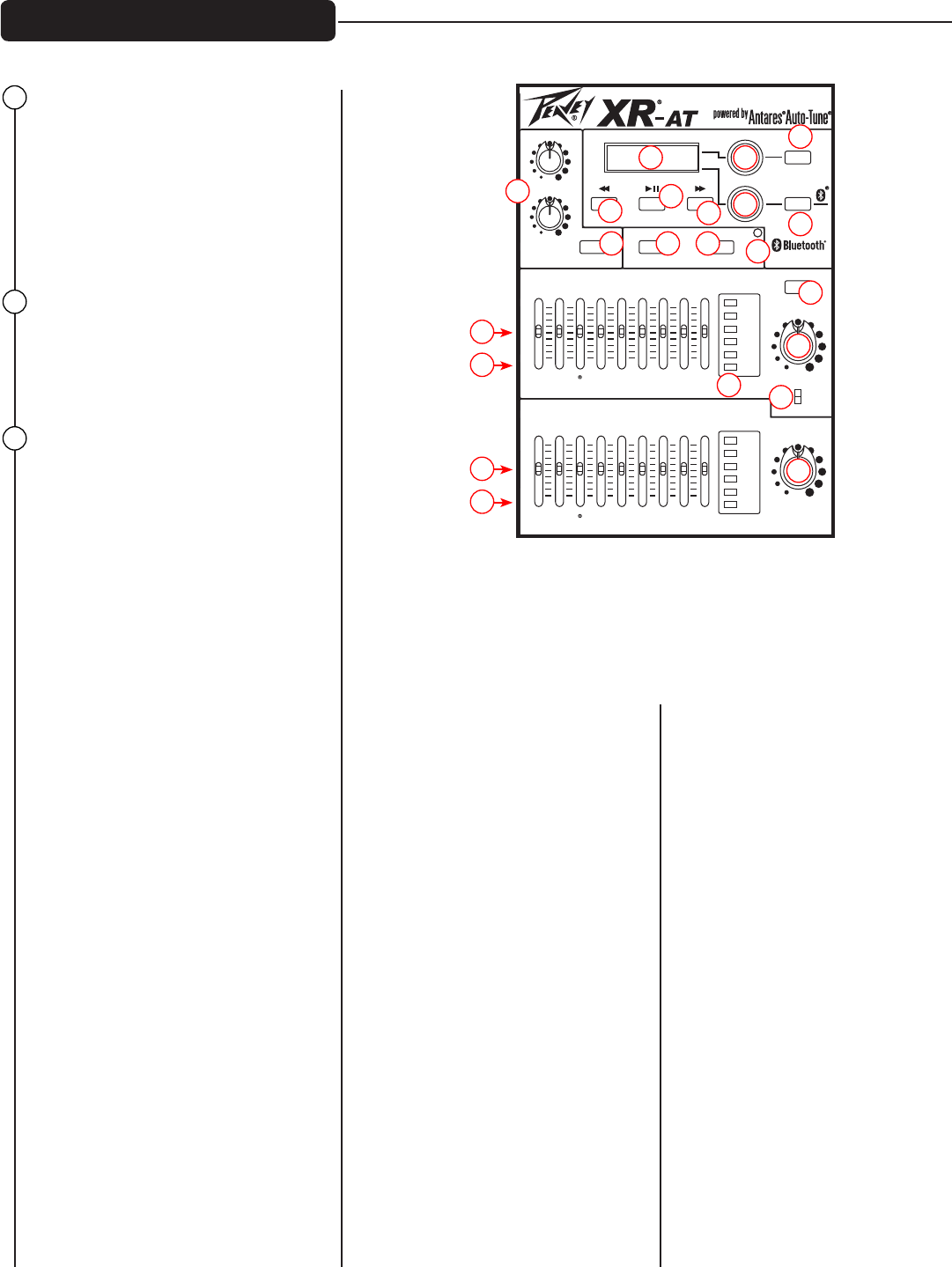
EDIT AUTO-TUNE
The Edit Auto-Tune® switch is used
to enter Auto-Tune editing mode.
When it is engaged (lit), the current
Auto-Tune preset will be displayed
on the LCD. When it is disengaged
(dark), the current EFX preset will
be displayed on the LCD.
MEDIA SELECT
This encoder is used to control
USB playback navigation. For
more information on this, see “USB
Playback.”
CH 9 INPUT SELECT (USB/BLUETOOTH)
This switch allows the user to
select the input signal being sent
to channel 9. It can select between
the USB A connector or a wireless
Bluetooth® connection from an
external device (Smart phone, iPod,
or tablet).
BLUETOOTH ACTIVE LED
The CH 9 INPUT button will
also function as the Bluetooth
Status LED. The blue backlit
switch indicates the status of the
Bluetooth connection. If the LED
is off, the Bluetooth module is
powered off and channel 9 is in
USB Playback Mode. If the LED
is slowly flashing, the XR-AT is
not paired with any device, but is
available for connection. When the
LED is lit solid, the source device
is properly paired to the mixer and
ready to play.
BLUETOOTH OPERATION
To listen to music via the Bluetooth
wireless connection, you must first
pair (link) your XR-AT mixer with
your Bluetooth phone and/or music
device.
Turn off any Bluetooth devices
previously paired with the XR-AT
mixer.
Turn on the Bluetooth feature on
your phone or music device.
Make sure the XR-AT is ready for a
Bluetooth connection.
The Bluetooth Active LED should
be blinking and the LCD will say,
“Bluetooth Input.”
Place your phone or music device in
Bluetooth search mode. The phone
or music device will begin searching
for the XR-AT.
Select “Peavey Mixer” from the
search results on your phone or
music device.
You will be prompted to enter a pin
number. Enter the pin#, it is 7878 (or
“PVPV” on a phone number pad).
If the pairing is successful, the
Bluetooth Active LED will blink
rapidly 5 times and then remain lit.
You are now ready to begin
streaming through Bluetooth to the
mixer. The level can be adjusted
from the connected source or by
the level control in Channel 9.
The XR-AT mixer will remember up
to 10 devices that it was previously
paired with and will automatically
connect to the last device with
which it was paired when turned
on. To clear the paired device
memory, make sure the mixer is
in Bluetooth mode and press and
hold the Ch 9 Input Select Button
(37) for 5 seconds. The XR-AT mixer
will ask if you would like to clear
the Bluetooth memory. Select "Y"
using the Media Select knob to
clear the memory. The XR-AT mixer
will go through the process of
clearing the memory, which should
take approximately 15 seconds.
Master Controls
35
36
37
comp
Auto-Tune
HIGHMID-MORPHLOW
LOW MID HIGH
LOW MID HIGH
MONITOREFFECTS COMPRESSOR
CH. 1
LEVEL
min max
min max
min max
min max
min max
comp
Auto-Tune
CH. 2
min max
min max
min max
min max
min max
high
min max
clip
sig
clip
sig
comp
Auto-Tune
CH. 3
min max
min max
min max
min max
min max
high
min max
clip
sig
comp
CH. 4
min max
min max
min max
min max
min max
high
min max
clip
sig
comp
CH. 5
min max
min max
min max
min max
min max
high
min max
clip
sig
comp
CH. 6
min max
min max
min max
min max
min max
high
min max
clip
sig
comp
CH. 7
min max
min max
min max
min max
min max
high
min max
clip
sig
CH. 8
min max
min max
min max
min max
min max
clip
sig
CH. 9
min max
min max min max
min max
min max
min max
clip
sig
LEVEL
MAIN
min max
+12
+6
0
-6
-12
63 125 250 500 1K 2K 4K 8K 12K
FLS FEEDBACK LOCATING SYSTEM
min max
high
LEVEL
MONITOR
min max
+12
+6
0
-6
-12
63 125 250 500 1K 2K 4K 8K 12K
FLS FEEDBACK LOCATING SYSTEM
SIGNAL
MON
MAIN
POWER AMP2 ASSIGN
EFX TO MON
Enable
KOSMOS-C
min max
min max
USB
MIC
LOW
HIGH
EFX
Edit
Auto-
Tune
Press to Select
Press to Select
efx clip
EFX / AUTO-TUNE
MEDIA SELECT
CH 9 INPUT
USB MEDIA PLAYBACK
DIGITAL EFFECTS
MUTE DEFEAT
ANALOG
MEDIA
CHANNEL
DIGITAL
MEDIA
CHANNEL
USB MEDIA
-6
-12
LIMIT
-18
-24
-30
SIGNAL
-6
-12
LIMIT
-18
-24
-30
Auto-Tune
Auto-Tune
Auto-Tune
18
18
19
19
35
3430
36
282726
31
32
33
25
29
37
23
22
20
24
21
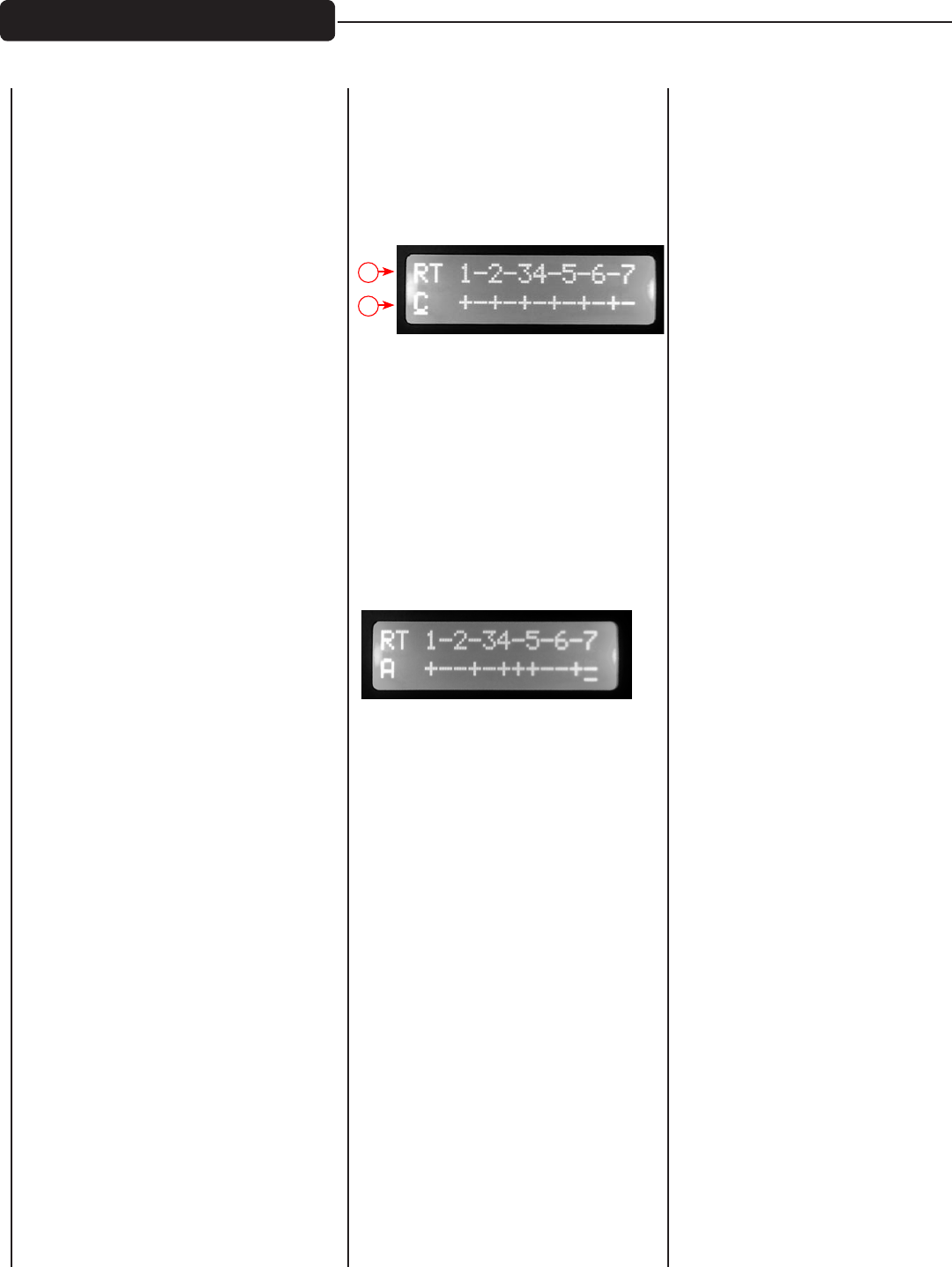
EFFECTS EDIT MODE:
In EFX Edit Mode, the EFX Select knob
is used to navigate through the EFX
presets. Turning the knob changes
the EFX preset in the display. The
new selection will be blinking in the
display; push the EFX Select knob
to choose the new effect. Once the
effect has been selected, you can
now edit the effect. To do this, press
the EFX Select knob and the display
will change to the current parameter
setting of the preset. Turn the EFX
Select knob to edit the parameter.
Press the knob again to exit EFX
preset edit mode. To restore the EFX
presets back to factory settings,
press and hold the EFX Select knob
for 5 seconds and select "Y" when
prompted.
AUTO-TUNE EDIT MODE:
In Auto-Tune® Edit Mode the EFX
Select knob is used to navigate
through the Auto-Tune presets.
Turning the knob changes the
Auto-Tune preset in the display. The
new selection will be blinking in the
display; push the EFX Select knob to
choose the new Auto-Tune preset.
Once the preset has been selected,
you can edit the preset by pressing
the EFX Select knob. The display will
change to the current Key setting.
Turn the EFX Select knob to change
the key and push the EFX Select knob
when you have chosen the key you
desire. The Key setting determines
which notes are enabled in the
Auto-Tune process. For example, in
the key of CMaj, the notes C, D, E, F,
G, A, and B are enabled, and all other
notes are disabled. To see which
notes are enabled or disabled for
each key, see the Key Table.
NOTE: If Custom Key is selected, the
display will enter Custom Key Edit
Mode. In this mode, you can create
a custom Auto-Tune Key. Use the
EFX Select knob to select the Root
(labeled "RT"). This will be the note
on which the custom key is based.
Then use the Media Select knob to
move the cursor and use the EFX
Select knob to activate or deactivate
the 12 notes in the key. Once you
have finished editing the custom key,
press the EFX Select knob to exit
Custom Key Edit Mode. The mixer is
capable of storing 9 different custom
keys, one for each preset slot.
The scale degrees are numbered across the
top, with half-steps indicated by a dash.
"+" indicates the note will be allowed.
"-" indicates the note will not be allowed.
By looking at the sequence of
allowed and disallowed notes above,
this is a whole tone scale. There are
only two of those, so you can have
the other one just by changing the
root to C# or B.
*This screen cap shows an A blues scale. You
don't have to edit the whole scale to change
keys - just change the root.
Once you have selected the key and
pressed the EFX Select knob, the
display will change to the current
Speed setting. Turn the EFX Select
knob to change the Speed setting.
The Speed setting determines
how quickly and aggressively the
Auto-Tune will correct the pitch.
The range for this setting is 0 to 25,
where 0 is the quickest and 25 is the
slowest. Push the EFX Select knob
when you are done editing the speed
parameter.
The display will now change to
the current Detune setting. Turn
the EFX Select knob to change the
Detune setting. The Detune setting
determines how the Auto-Tune pitch
correction is calibrated. When the
Detune setting is 0 cents, this means
the Auto-Tune is calibrated to the
standard A440, or where the note
A4 equals 440 Hz. The range of the
Detune setting is -64 to 63 cents,
a width of 128 cents. The distance
between two notes, or semitones,
is 100 cents, which means that the
Auto-Tune can be detuned to fit any
possible environment.
NOTE: Detuning the Auto-Tune can
be very useful, especially when
being used in conjunction with an
instrument that is not easily tuned
on-the-fly. For example, if a piano is
accompanying Auto-Tuned vocals
and the piano is slightly out of tune
from the A440 standard, simply
change the Detune setting in the
Auto-Tune setting. This is much
easier and takes much less time
than having someone tune the entire
piano! Also, although the Detune
setting is changed in the Auto-Tune
preset edit mode, this is a global
parameter. This means if you change
the Detune setting and then later
change the Auto-Tune preset, the
Detune setting will not change.
Once you have selected the
appropriate Detune setting, press
the EFX Select knob to exit Auto-Tune
preset edit mode. To restore all
Auto-Tune presets back to factory
settings, press and hold the EFX
Select knob for 5 seconds and select
"Y" when prompted.
NOTE: Preset 9 is chromatic with
speed set to 7. It is recommended
for general purpose, safe, easy
use of Auto-Tune, without having
to adjust any settings. The slower
speed setting does not produce a
robotic effect on the voice, and all
twelve semitones are allowed. Just
remember to use footswitch #2 to
bypass Auto-Tune between songs,
otherwise your speaking will be
Auto-Tuned!
Operating The DSP
RT=Root or Key
*indicates the root or key is C
RT
*

Auto-Tune Key Table
Key Display Note Number (n)=
Key 0 1 2 3 4 5 6 7 8 9 10 11
Chrom C C# D D# E F F# G G# A A# B
C Maj C D E F G A B
C Mnr C D D# F G G# A#
C#Maj C C# D# F F# G# A#
C#Mnr C# D# E F# G# A B
D Maj C# D E F# G A B
D Mnr C D E F G A A#
D#Maj C D D# F G G# A#
D#Mnr C# D# F F# G# A# B
E Maj C# D# E F# G# A B
E Mnr C D E F# G A B
F Maj C D E F G A A#
F Mnr C C# D# F G G# A#
F#Maj C# D# F F# G# A# B
F#Mnr C# D E F# G# A B
G Maj C D E F# G A B
G Mnr C D D# F G A A#
G#Maj C C# D# F G G# A#
G#Mnr C# D# E F# G# A# B
A Maj C# D E F# G# A B
A Mnr C D E F G A B
A#Maj C D D# F G A A#
A#Mnr C C# D# F F# G# A#
B Maj C# D# E F# G# A#
B Mnr C# D E F# G A B
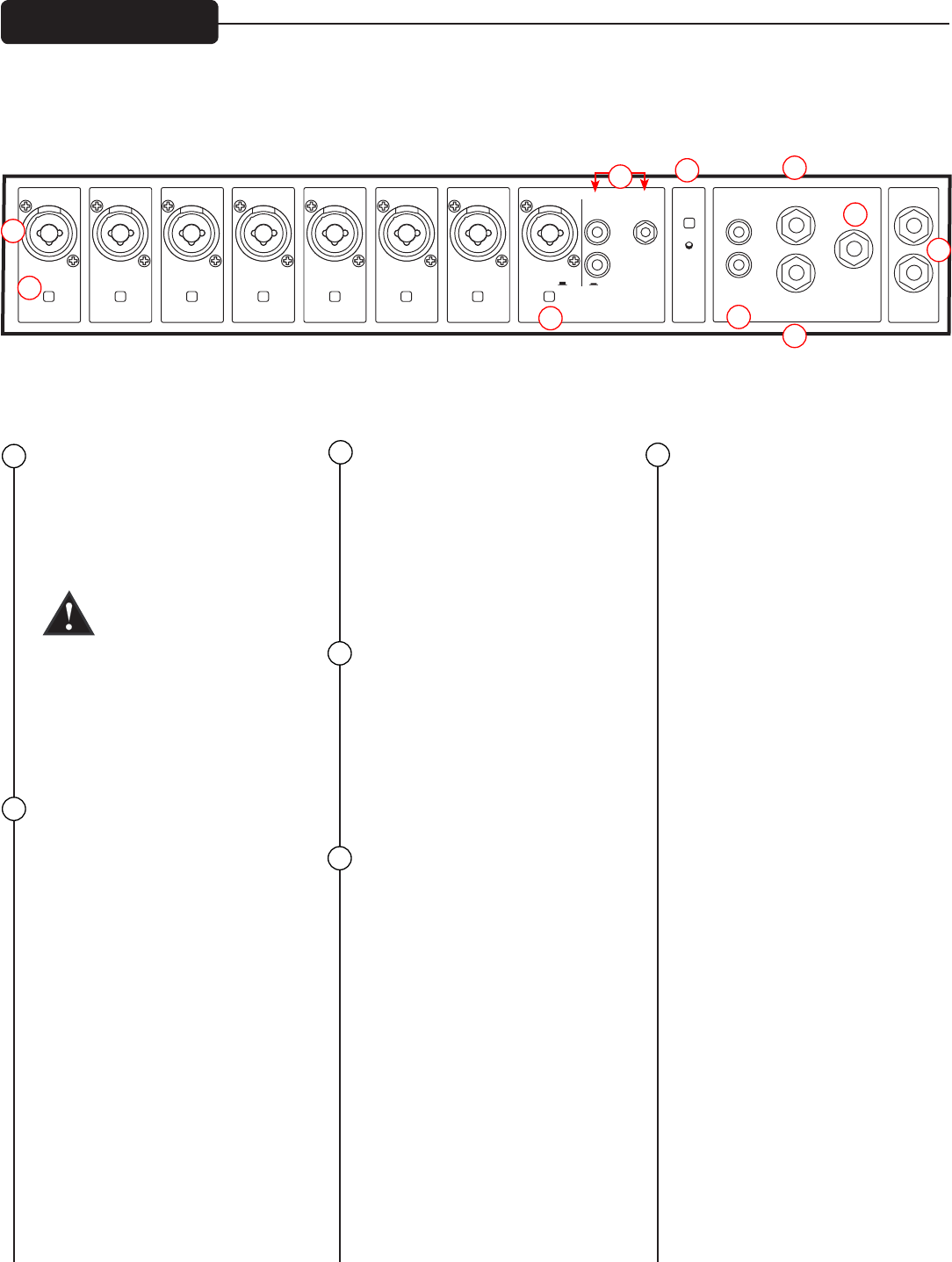
Inputs/Outputs
GLOBAL PHANTOM POWER
This switch, when depressed,
applies +48 VDC to all input XLR
connectors to power microphones
that need phantom power to work.
This switch applies +48
VDC voltage to the input
XLR connectors to power
microphones requiring phantom
power. If phantom power is
used, do not connect unbalanced
dynamic microphones or other
devices that cannot handle this
voltage to the XLR inputs.
RCA RECORD OUT
This pair of RCA jacks provides a
signal to the recording inputs of a
CD recorder, stereo tape deck or
other recording device.
NOTE: Do not connect a single
device to the Media Inputs (3) and
Record Outputs. This improper
setup forms a loop, which can
cause severe feedback.
MAIN OUT (TRS Balanced)
This 1/4" jack provides a signal
from the main mix (after the
graphic EQ) for an external power
amplifier. An external power
amplifier, such as our IPR® series
of amplifiers, can then drive
additional speakers.
MONITOR OUT (TRS Balanced)
This 1/4" jack provides a signal
from the monitor mix (after the
graphic EQ) for an external power
amplifier. An external power
amplifier, such as our IPR series
of amplifiers, can then drive
additional speakers.
SUB/MONO OUT (TRS Balanced)
This 1/4" jack provides a signal
that passes all signals under
150Hz. This can be used to drive
an external subwoofer amplifier or
a powered sub. The level of signal
tracks the main output.
POWER AMP INPUTS
These are 1/4" inputs that allow
an external line-level signal to be
connected to each of the built-in
power amps. Plugging an input into
these jacks breaks the signal from
the mixer to the built-in amplifier.
The mixer output is still available at
the Main out jack (40).
38
39
40
41
43
42
PAD
1
PAD
2
PAD
3
PAD
4
PAD
5
PAD
6
PAD
7 8
L
R
MEDIA
INPUTS
RCA 3.5mm
TRS
SUB OUT
TRS BAL
TRS BAL
MAIN OUT
TRS BAL
MONITOR OUT
NON-POWERED OUTPUTS
L
R
RECORD OUT
UNBAL
AMP 2
AMP 1
POWER AMP IN
ENABLE
ACTIVE
GLOBAL
PHANTOM
POWER
INPUT SELECT
MEDIAXLR-1/4”
38
39
42
43
41
40
4
1
2
3
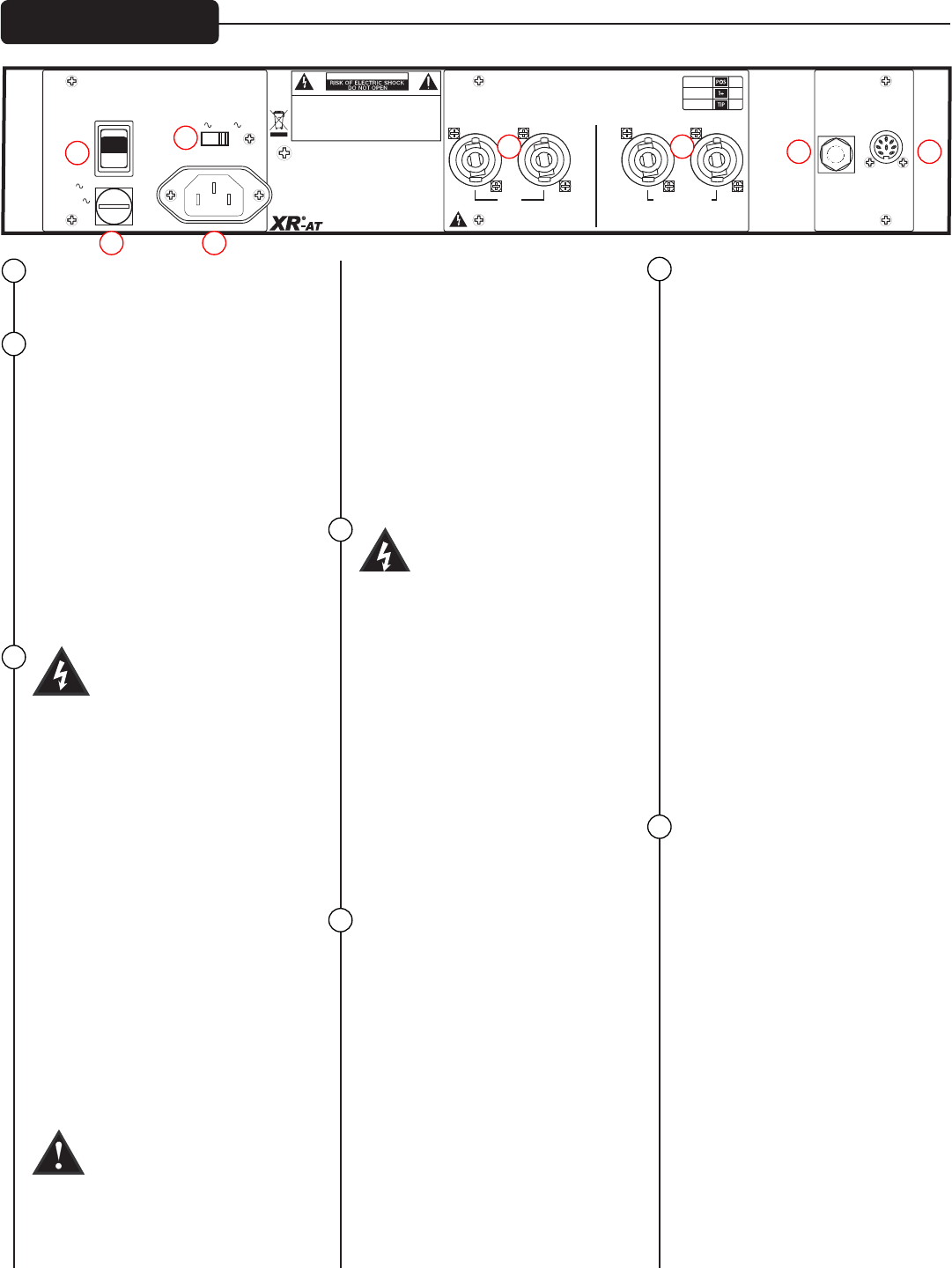
Rear Panel
POWER SWITCH
This is the main power switch.
FUSE
This is the main safety fuse for the
AC line voltage. Only replace with
a fuse of the exact type and rating.
If the fuse continues to open, do
not over fuse. Take the unit to an
authorized Peavey service center.
NOTE: If the main AC voltage is
changed, the fuse must also be
changed to one of the appropriate
rating for the voltage you are
switching to.
AC POWER INLET
This is the receptacle for an
IEC line cord, which provides
AC power to the unit. Connect
the line cord to this connector to
provide power to the unit. Damage
to the equipment may result if
improper line voltage is used. (See
line voltage marking on unit.)
Never break off the ground pin
on any equipment. It is provided
for your safety. If the outlet used
does not have a ground pin, a
suitable grounding adapter should
be used and the third wire should
be grounded properly. To prevent
risk of shock or fire hazard, always
make sure that the amplifier and all
associated equipment is properly
grounded.
NOTE: FOR UK ONLY
As the colors of the wires
in the mains lead of this
apparatus may not correspond
directly with the colored markings
identifying the terminals in your
plug, proceed as follows: (1) The
green and yellow wire must be
connected to the terminal which is
marked with the letter E, or by the
earth symbol, or is colored green, or
green and yellow. (2) The blue wire
must be connected to the terminal
which is marked with the letter N, or
the color black. (3) The brown wire
must be connected to the terminal
which is marked with the letter L, or
the color red.
VOLTAGE SELECTOR
SWITCH
This switch allows the user
to select between 115VAC / 60Hz
or 230VAC / 50Hz. To change the
voltage selector, you must first
unscrew and remove the plastic
cover that protects the switch.
After changing the voltage, please
replace the plastic cover to ensure
the voltage level is not inadvertently
altered.
NOTE: The fuse MUST be changed to
the appropriate value to match the
voltage you have selected. Please
see the note on the back of the
mixer for the correct value.
POWER AMP 1 SPEAKER OUTPUTS
(MAIN MIX)
Dual two-conductor 1/4" –
Speakon® combination jacks that
can be connected to your speakers.
Each amplifier has a minimum load
impedance of 4 ohms. This means
you can connect either one 4-ohm,
one 8-ohm or two 8-ohm speakers
to each amplifier. Do not operate
below rated minimum impedance.
For maximum power transfer and to
prevent damage to your amplifier, be
sure to use speaker cables and not
instrument cables to connect to the
speakers. We recommend the use of
18-gauge or larger speaker wire.
POWER AMP 2 SPEAKER OUTPUTS
(MAIN MIX or MONITOR MIX)
Dual two-conductor 1/4" – Speakon
combination jacks that can be
connected to your speakers. Each
amplifier has a minimum load
impedance of 4 ohms. This means
you can connect either one 4-ohm,
one 8-ohm or two 8-ohm speakers
to each amplifier. Do not operate
below rated minimum impedance.
For maximum power transfer and to
prevent damage to your amplifier,
be sure to use speaker cables and
not instrument cables to connect to
the speakers. We recommend the
use of 18-gauge or larger speaker
wire. The signal going to Power Amp
2 is determined by the position of
the Power Amp 2 Assign switch (24).
In the “MAIN” position, the main
mix is fed to power amp 1 and power
amp 2. In the “MON” position, the
main mix is fed to power amp 1 and the
monitor mix is fed to power amp 2.
FOOTSWITCH EFFECTS DEFEAT (TS)
This 1/4" jack accepts a momentary,
dual - footswitch (Peavey Part#
03014070) designed to defeat the
effects on all channels or toggle the
Auto-Tune® on/off. Pressing switch
1 of the footswitch will toggle the
effects on and off. The condition
will be indicated by the EFX Defeat
button on the front panel. When
defeated, the button will be red.
When the effects are active, the
button will be dark. Pressing switch
2 will toggle the Auto-Tune on /
off (globally). The status will be
indicated by the three Auto-Tune
on/off switches (5) at the top of
the first 3 channels. If Auto-Tune is
active, the switch will be amber. If it
is inactive, the switch will be dark.
44
45
46
47
49
50
48
POWER
ON
A/C
MAIN
50/60 Hz 200 WATTS
Consumo de energia 200 Wh
POWER AMP 1
POWER AMP 2
SPEAKER OUTPUTS
MINIMUM LOAD
4 OHMS PER AMPLIFIER
CLASS 2 WIRING
MAIN/MONITOR
(WITH FRONT PANEL MONITOR SWITCH ACTIVE THESE
OUTPUTS RECEIVE SIGNAL FROM MONITOR SECTION)
FOOTSWITCH
8PIN/MIDI
AUTO-TUNE
PRESETS
EFFECTS\
AUTO-TUNE
DEFEAT
TIP- EFX DEFEAT
RING- AT DEFEAT
FUSE
115V
230V
FOR 220-240V OPERATION, FUSE
MUST BE CHANGED TO T5AH/250V
FOR 115V OPERATION, FUSE
MUST BE CHANGED TO T10AH/250V
220-240V
T5AH/250V
115V
T10AH/250V
HAZARD, REPLACE WITH SAME TYPE 250 VOLT FUSE.
PAR UN FUSIBLE DE MEME TYPE ET DE 250 VOLTS.
CAUTION
AVIS:
BE PLACED ON THIS APPARATUS. TO PREVENT THE RISK OF FIRE
TO REDUCE THE RISK OF FIRE OR ELECTRIC SHOCK,
WARNING:
THIS APPARATUS SHOULD NOT BE EXPOSED TO RAIN OR MOISTURE
AND OBJECTS FILLED WITH LIQUIDS, SUCH AS VASES, SHOULD NOT
TEL QU’UN VASE, NE DOIT ETRE POSE SUR CELUI-CI. REMPLACER
DANS LE BUT DE REDUIRE LES RISQUES D’INCENDIE OU DE
DECHARGE ELECTRIQUE, CET APPAREIL NE DOIT PAS ETRE EXPOSE
A LA PLUIE OU A L’HUMIDITE ET AUCUN OBJET REMPLI DE LIQUIDE,
AVIS: RISQUE DE CHOC ELECTRIQUE-NE PAS OUVRIR
MADE IN CHINA
DESIGNED AND ENGINEERED IN U.S.A.
A PRODUCT OF PEAVEY ELECTRONICS CORP.
CAN-ICES-3B/NMB-3B
FCC ID: I4S-XR-
AT
IC: 3642B-XR-
AT
THIS DEVICE COMPLIES WITH PART 15 OF THE FCC RULES.
OPERATION IS SUBJECT TO THE FOLLOWING TWO CONDITIONS:
(1) THIS DEVICE MAY NOT CAUSE HARMFUL INTERFERENCE, AND
(2) THIS DEVICE MUST ACCEPT ANY INTERFERENCE RECEIVED,
INCLUDING INTERFERENCE THAT MAY CAUSE UNDESIRED OPERATION.
CONNECTORS COMPATIBLE
WITH TWIST-LOCK
CONNECTORS AND 1/4”
SPEAKER CABLE
1-
NEG
PINOUT
TWIST-LOCK
1/4”
SLV
44
45 46
47
48 49 50 51

AUTO-TUNE FOOTSWITCH
MIDI In/Footswitch
This 8-pin DIN connector is provided for the connection of the Peavey 5-Button MIDI Footswitch. Preferably this should be connected before
the mixer is powered up. See the “Peavey 5-Button MIDI Footswitch” section of this manual for a more detailed explanation of operation.
This can also be used as a MIDI IN connection, using a standard 5-pin MIDI cable, if the mixer is going to be controlled by a separate MIDI
controller other than the Peavey footswitch. See the “MIDI” section of this manual for a more detailed explanation of the MIDI features.
PEAVEY 5-BUTTON MIDI FOOTSWITCH
The XR-AT Auto-Tune® can be controlled using the Peavey 5-Button MIDI Footswitch. Connect the footswitch to the XR-AT with the 8-pin MIDI
cable provided with the footswitch. The 8-pin cable must be used because it provides power to the footswitch. The footswitch will initialize
itself and reflect the current Auto-Tune preset selection. Below are the descriptions of each button on the Peavey 5-Button MIDI Footswitch for
the XR-AT.
1 = Auto-Tune Enable/Disable (LED Green = Enabled, LED Red = Disabled)
2 = Preset Selector 1
3 = Preset Selector 2
4 = Preset Selector 3
5 = Preset Bank Selector (LED Off = Bank 1 , LED Red = Bank 2, LED Green = Bank 3)
Pressing the Auto-Tune Enable/Disable button will globally disable all Auto-Tune channels. This is useful when a performer is speaking
between songs at a performance; the performer can disable the Auto-Tune while speaking into the microphone so that the XR-AT does not
apply Auto-Tune to their speech. Pressing the switch again will enable the Auto-Tune channels that were enabled previously. If the Auto-Tune
is globally disabled and one of the Auto-Tune channel buttons on the XR-AT mixer is pressed, the Auto-Tune will automatically globally enable
but will only enable the Auto-Tune channel that was selected.
Buttons 2-4, the Preset Selector buttons, allow the performer to change Auto-Tune presets on-the-fly along with button 5, the Preset Bank
Selector. Below is a table describing which Auto-Tune preset will be selected when using the Preset Selector buttons and the Preset Bank
Selector button.
BANK 1 (LED OFF) BANK 2 (LED RED) BANK 3 (LED GREEN)
Preset Selector 1 Preset 1 Preset 4 Preset 7
Preset Selector 2 Preset 2 Preset 5 Preset 8
Preset Selector 3 Preset 3 Preset 6 Preset 9
MIDI
The XR-AT Auto-Tune is also capable of being controlled with other types of MIDI controllers by using a standard 5-pin MIDI cable. It is capable
of receiving Control Change messages and Program Change messages, as laid out by the MIDI standard. This is the information you need to
use this mixer with other MIDI devices.
MIDI CC:
MIDI Control Change messages are used to change one function at a time. After selecting a preset (see MIDI Program below), modifications to
that preset can be done with these messages.
Note: The XR-AT is designed to receive MIDI messages on MIDI Channel 1, so the first byte of every Control Change message should be B0h.
CONTROL CONTROLLER NUMBER DATA
Channel 1 Enable 01h 00h-3Fh (Off) OR 40h-7Fh (On)
Channel 2 Enable 02h 00h-3Fh (Off) OR 40h-7Fh (On)
Channel 3 Enable 03h 00h-3Fh (Off) OR 40h-7Fh (On)
N/A 04h N/A
Speed 05h 00h-19h (0-25)
N/A 06h N/A
N/A 07h N/A
Detune 08h 00h-7Fh (0-127)
Example: B0 05 0F
Changes Speed to 15
MIDI PROGRAM:
MIDI Program Changes are used to recall Auto-Tune presets.
The XR-AT is designed to receive MIDI messages on MIDI Channel 1, so the first byte of every Program Change message should be C0h. The
second byte should be the preset number minus one.
Example: C0 05
Recalls Auto-Tune preset 6
51
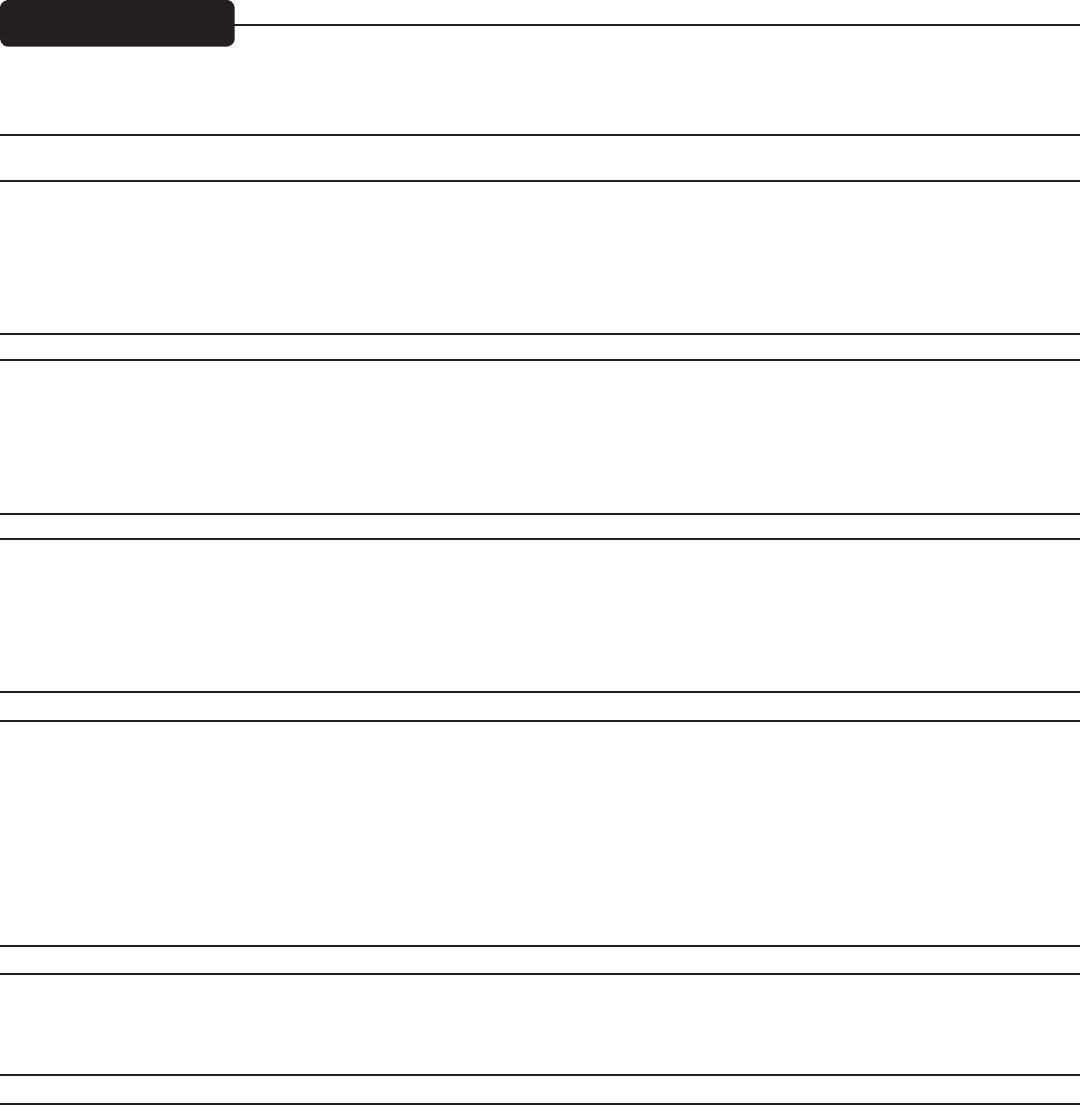
Effects (parameter)
PLATE (TIME) DESCRIPTION PREDELAY ROOM ROOM SIZE FRONT END HP BACK END LP MORE DESCRIPTIVE
DAMP FACTOR NAME
P1 Bright 35 ms
P2 Gentle LP 48 ms
P3 Med LP 62 ms
P4 Hard LP 78 ms
P5 Dark 95 ms
HALL (TIME)
H1 Vox Fox 35 ms Med Med Subtle Subtle Med Hall
H2 Vox Huge 42 ms Med Large Subtle Subtle Cathedral
H3 Vox Glow 10 ms Med Large Subtle Subtle Auditorium
H4 Strings 30 ms Med Med Subtle Subtle Concert Hall
H5 Brass Hall 35 ms High Med Subtle Moderate Concert Hall 2
ROOM (TIME)
R1 Vox Air 30 ms Low Small Aggressive Subtle Hard Walls
R2 Vox Club 35 ms High Small Subtle Moderate Club
R3 Snare Low 70 ms Low Small Moderate Subtle Bathroom
R4 AC GTR 42 ms Med Small Moderate Subtle Med Walls
R5 Brass Room 40 ms High Med Subtle Moderate Med Room Damped Walls
DELAY (TIME)
D1 Double
D2 Slapback
D3 Bright, Few Repeats
D4 Bright, More Repeats
D5 Bright, Most Repeats
D6 Dark, Few Repeats
D7 Dark, More Repeats
D8 Dark, Most Repeats
ENHANCE (CUTOFF FREQ)
E1 Light Harmonics
E2 Moderate Harmonics
E3 Heavy Harmonics
CHORUS (RATE) PREDELAY CHORUS TIME RATE MODULATION
C1 High Depth, Slow Rate 10 ms 20 ms 0.1 – 1 Hz Random Sine
C2 Mod Depth, Wide Rate 10 ms 5 ms 0.5 - 4 Hz Random Sine
C3 Short Depth, Wide Rate 10 ms 2 ms 0.5 - 6 Hz Sine
C4 Short Depth, Fast Rate 5 ms 1 ms 5 - 15 Hz Random Sine
C5 High Depth, Mod Rate 2 ms 20 ms 0.2 - 3 Hz Random Sine
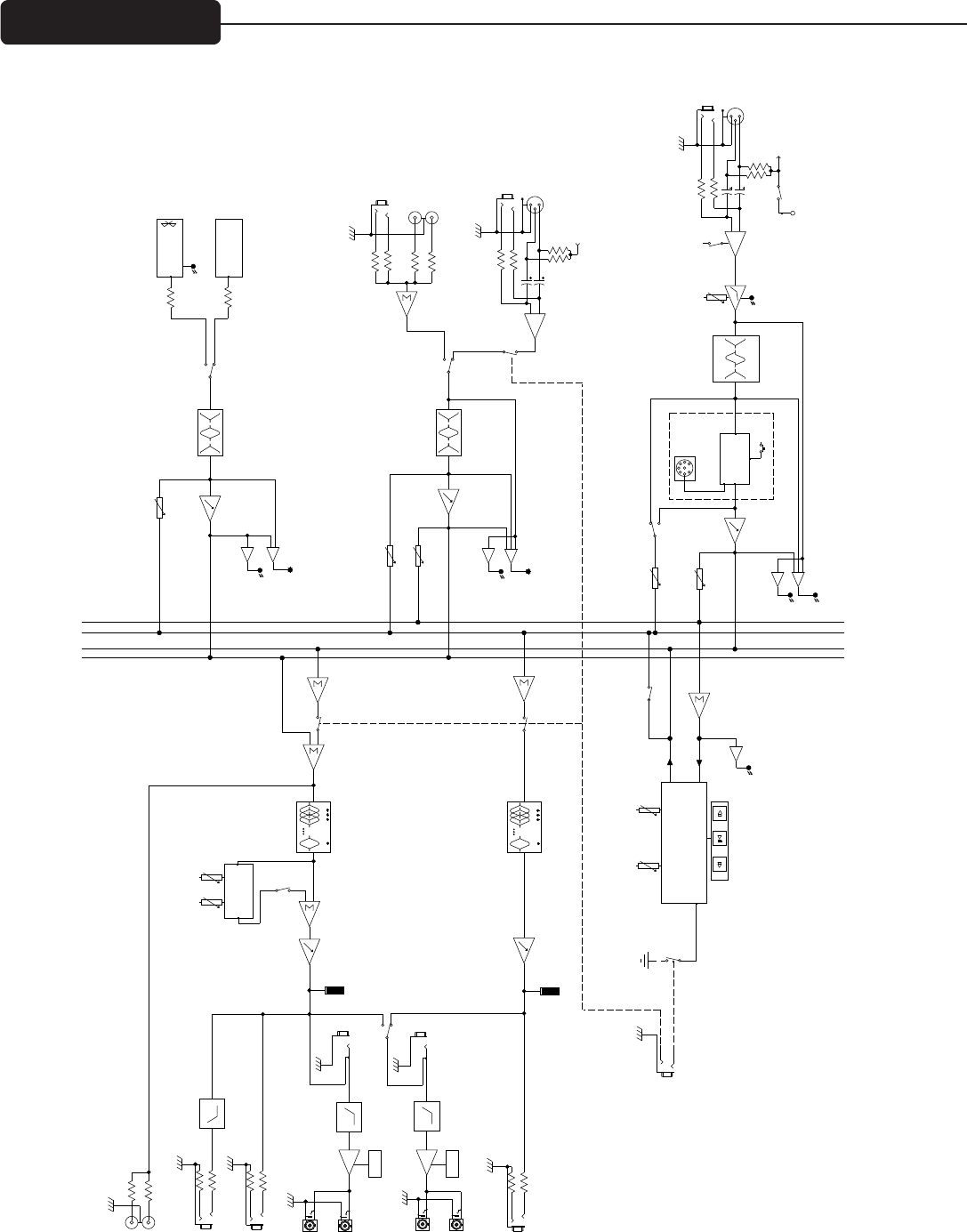
HI PASS
HI PASS 1-
1+
Meridian, MS 39301
Peavey Electronics Corp.
P. O. Box 2898
4
3
2
1
D
4
3
2
1
CBA
A B C D
Sheet Title:
Title:
Sheet Date:
of
D
LO PASS
+48V
EQ
LO MID HI
Graphic EQ with FLS
Graphic EQ with FLS
EQ
LO MID HI
LO
80Hz
4kHz
MID-MORPH
12kHz
HI
400Hz
1-
1+
1-
1+
1-
1+
3
GND
1
2
T
R
S
3
GND
1
2
T
R
S
OUTPUTS
ON/OFF
SELECTOR
EFX
OUT
CLIP
FOOTSWITCH
DEFEAT
REC
OUT
AMP2
OUT
AMP1
MAIN
OUT
MON
LEVEL
SIGNAL
CLIP
LEVEL
EFX
SIGNAL
LEFT
RIGHT
SIGNAL
MIC PRE
EFX
MON
EFX
LEVEL
USB INPUT
EQ LEVEL
MONITOR
CLIP
LIMITER
LIMITER
MUTE
MICS
DEFEAT / MUTE MICS
VOLUME
MASTER
ASSIGN
VOLUME
MONITOR
LOW
MUTE
LINE
INPUT
BLUETOOTH
SUB
EFX
EFX
EFFECTS
MEDIA
SELECTOR
MICS
MUTE
AMP2
EQ
9 - BAND EQ
9 - BAND EQ
EQ
HIGH
CHANNEL 8
MEDIA PLAYER
MIC PRE
USB
BLUETOOTH/
CHANNEL 9
CHANNEL 1 - 7
AMP2 IN
AMP1 IN
MICS
CH. 1-7
CH. 8/9
CLIP
MONITOR
COMP
LEVEL
KOSMOS ENABLE
MONITOR
STATUS
AUTO-TUNE
TO MONITOR
AUTO-TUNE
PAD
MONITOR
EFX TO
LINE
XLR
KOSMOS - C
XLR
LINE
XLR-1/4"
SELECT
MP3 IN
AMP2
SPEAKER
POWER
AMP1
POWER
CH 1-3 ONLY
ON/OFF
FOOTSWITCH
PRESET
COMBO
COMBO
PHANTOM
PHANTOM
XR_AT_BLK
8-22-2014_10:392 2
Block Diagram
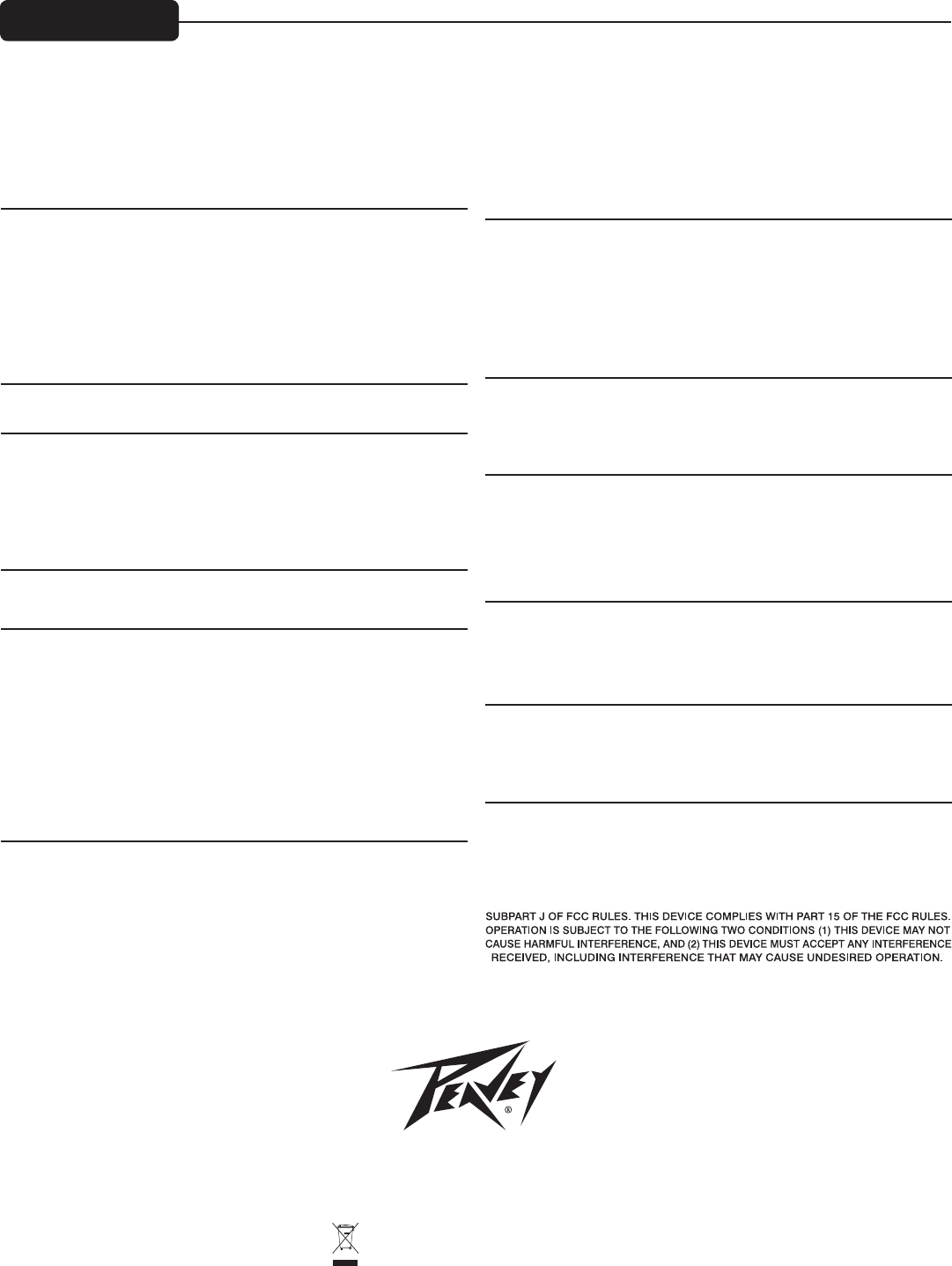
Specifications
INPUT SENSITIVITY:
Mic In to full power at the power amp. Master Volume Nom.
Full Nominal
-40 dBu -22 dBu
Line In to full power at the power amp. Master Volume Nom.
Full Nominal
-10 dBu +8 dBu
CHANNEL EQ:
Shelving EQ
Low EQ 80 Hz ±15 dB
Mid-Morph
Low 250 Hz ±15 dB
High 4 kHz ±15 dB
High EQ 12 kHz ±15 dB
CLIP LED:
Clip LEDs come on 3 dB before clipping.
FREQUENCY RESPONSE:
All controls nominal (detent)
Mic to Main 20 Hz – 20 kHz +0, -1 dB
Line to Main 20 Hz – 30 kHz +0, -1 dB
Mic to Amp 50 Hz – 20 kHz +0, -3 dB
Line to Amp 40 Hz – 20 kHz +0, -3 dB
PHANTOM POWER:
+48 VOLTS
NOISE:
Main = Main line output, 22 – 22 kHz filter
Amp 1 = Amplifier output, loaded at 4 Ohms, through AP
AUX-0025 switching amplifier filter
All controls full down.
Main <-95 dBu
Amp 1 <-60 dBu
Master Volume nominal
Main <-88 dBu
Amp 1 <-55 dBu
THD:
All controls nominal
<0.01% @ main line output, -30 dBu in mic input Channel 1
<0.5% @ amp 1 @ 400 Watts into 4 Ohms
All controls nominal
<0.005% @ main line output, +4 dBu in line input Channel 1
<0.5% @ amp 1 @ 400 Watts into 4 Ohms
MASTER EQ:
80Hz ±12 dB
250Hz ±12 dB
500Hz ±12 dB
1kHz ±12 dB
2kHz ±12 dB
4kHz ±12 dB
10kHz ±12 dB
METER ARRAY:
LIMIT
-6 dB
-12 dB
-18 dB
-24 dB
-30 dB
AMP LIMITER:
Limits amplifier power just before clipping. The limiter holds the amp
power without clipping and can be driven up to 18 dB past maximum
output.
AMPLIFIER OUTPUT POWER:
120VAC
Both channels loaded at 8 ohms: 280 Watts RMS per ch
Both channels loaded at 4 ohms: 500 Watts RMS per ch
POWER REQUIREMENTS:
Domestic: 120VAC 50/60Hz 200 Watts Nominal
Export: 230VAC 50/60Hz 200 Watts
Nominal
SIZE:
Dimensions: H x W x D
9.5" x 19" x 9.5"
24.13cm x 48.26cm x 24.13cm
WEIGHT: 16 lbs.
7.25 kgs
Features and specifications subject to change without notice.
Peavey Electronics Corporation • 5022 Hartley Peavey Drive • Meridian, MS • 39305
(601) 483-5365 • FAX (601) 486-1278 • www.peavey.com • 31700107 • ©2015
Logo referenced in Directive 2002/96/EC Annex IV
(OJ(L)37/38,13.02.03 and defined in EN 50419: 2005
The bar is the symbol for marking of new waste and
is applied only to equipment manufactured after
13 August 2005

Notes
______________________________________________________________________________________________________________________
______________________________________________________________________________________________________________________
______________________________________________________________________________________________________________________
______________________________________________________________________________________________________________________
______________________________________________________________________________________________________________________
______________________________________________________________________________________________________________________
______________________________________________________________________________________________________________________
______________________________________________________________________________________________________________________
______________________________________________________________________________________________________________________
______________________________________________________________________________________________________________________
______________________________________________________________________________________________________________________
______________________________________________________________________________________________________________________
______________________________________________________________________________________________________________________
______________________________________________________________________________________________________________________
______________________________________________________________________________________________________________________
______________________________________________________________________________________________________________________
______________________________________________________________________________________________________________________
______________________________________________________________________________________________________________________
______________________________________________________________________________________________________________________
______________________________________________________________________________________________________________________
______________________________________________________________________________________________________________________
______________________________________________________________________________________________________________________
______________________________________________________________________________________________________________________
______________________________________________________________________________________________________________________
______________________________________________________________________________________________________________________
______________________________________________________________________________________________________________________
______________________________________________________________________________________________________________________
______________________________________________________________________________________________________________________
______________________________________________________________________________________________________________________
______________________________________________________________________________________________________________________
______________________________________________________________________________________________________________________
______________________________________________________________________________________________________________________
______________________________________________________________________________________________________________________
______________________________________________________________________________________________________________________
______________________________________________________________________________________________________________________
______________________________________________________________________________________________________________________
______________________________________________________________________________________________________________________

Notes
______________________________________________________________________________________________________________________
______________________________________________________________________________________________________________________
______________________________________________________________________________________________________________________
______________________________________________________________________________________________________________________
______________________________________________________________________________________________________________________
______________________________________________________________________________________________________________________
______________________________________________________________________________________________________________________
______________________________________________________________________________________________________________________
______________________________________________________________________________________________________________________
______________________________________________________________________________________________________________________
______________________________________________________________________________________________________________________
______________________________________________________________________________________________________________________
______________________________________________________________________________________________________________________
______________________________________________________________________________________________________________________
______________________________________________________________________________________________________________________
______________________________________________________________________________________________________________________
______________________________________________________________________________________________________________________
______________________________________________________________________________________________________________________
______________________________________________________________________________________________________________________
______________________________________________________________________________________________________________________
______________________________________________________________________________________________________________________
______________________________________________________________________________________________________________________
______________________________________________________________________________________________________________________
______________________________________________________________________________________________________________________
______________________________________________________________________________________________________________________
______________________________________________________________________________________________________________________
______________________________________________________________________________________________________________________
______________________________________________________________________________________________________________________
______________________________________________________________________________________________________________________
______________________________________________________________________________________________________________________
______________________________________________________________________________________________________________________
______________________________________________________________________________________________________________________
______________________________________________________________________________________________________________________
______________________________________________________________________________________________________________________
______________________________________________________________________________________________________________________
______________________________________________________________________________________________________________________
______________________________________________________________________________________________________________________
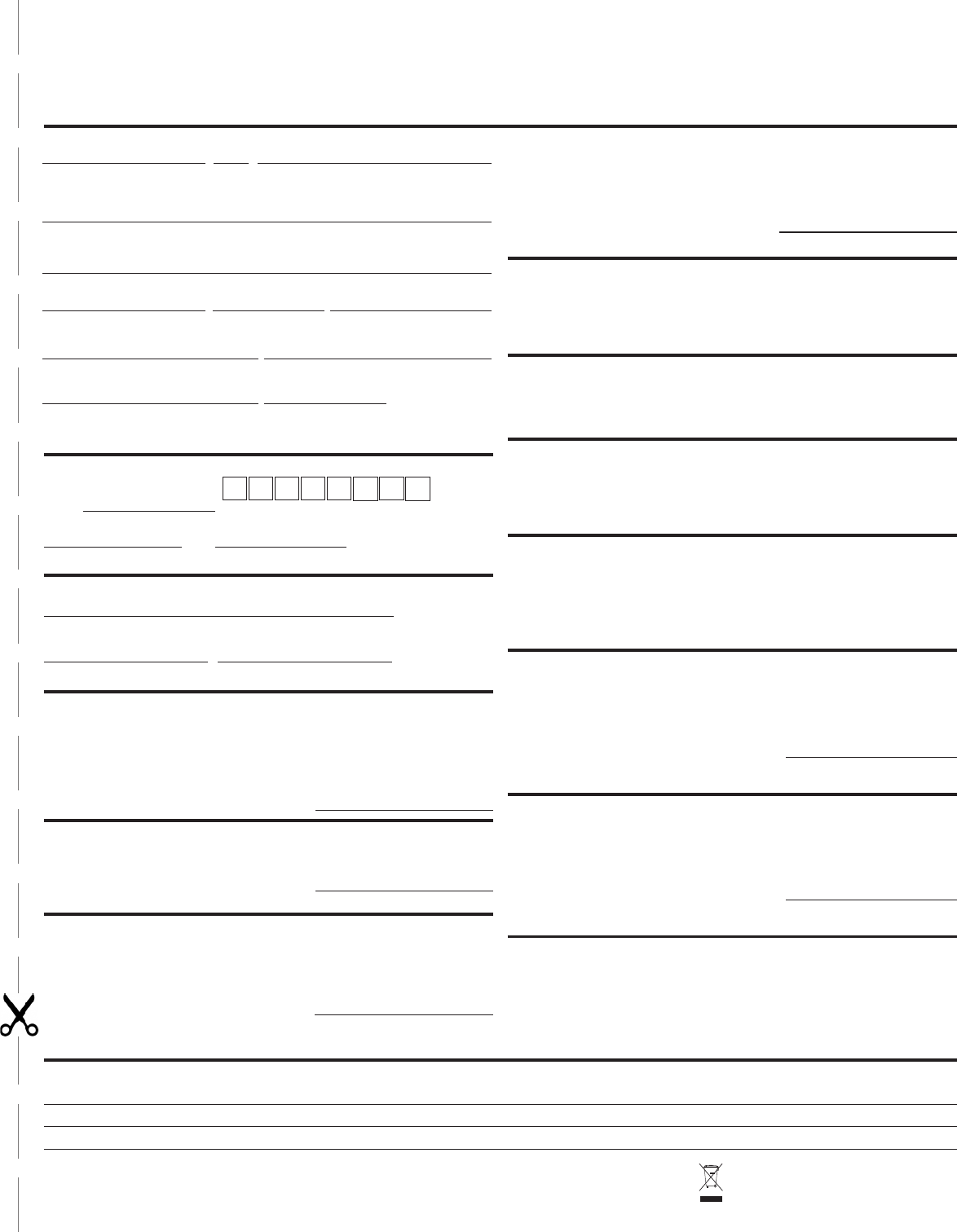
U.S. CUSTOMER WARRANTY REGISTRATION
Optional Product Extended Warranty Registration
Give us some information and put your extended warranty into effect!
9. How would you describe your level of musicianship/technical expertise?
1.
First Name Initial Last Name
Street Address
City State/Province Postal Code
( )
Telephone Number E-mail Address
( ) - -
Fax Number Date of birth
2.
Model 8-Digit Serial Number
Date of Purchase Price Paid
3.
Name of store where purchased
City State
4. Top two (2) reasons why you purchased from this store/dealer:
8. Which other brands/models did you consider?
❒ Past favorable experience
❒ Best price
❒ Advertised special
❒ Convenient location
❒ Received as a gift
❒ Other
❒ Availability of product
❒ Friend/Relative’s recommendation
❒ Store credit card
❒ Knowledgeable staff
❒ Availability of lessons
❒ Technical instruction
6. What two (2) factors most influenced your purchase of this product?
❒ Peavey brand name
❒ Craftsmanship
❒ Features for price
❒ Bundled accessories
❒ Sound quality
❒ Product appearance
❒ Durability
❒ Prior experience with Peavey
❒ Packaging
❒ Other
❒ Beginner - Never played or taken less than one (1) year of lessons
❒ Intermediate - One (1) to five (5) years of lessons or playing
❒ Advanced - More than five (5) years of lessons or playing; play professionally
10. Education: (select best answer)
❒ High school
❒ Some college
❒ Completed college
❒ Graduate school
Gender ❒ M ❒ F
11. Which best describe your family income? (select best answer)
12. Which of the following is your primary source of information on musical
products: (select best answer)
Please take a few minutes to fill out this information/survey sheet to help us get to know and serve you better.
To save time, submit your warranty registration online at www.peavey.com/support/warrantyregistration
❒ Under $15,000
❒ $15,000 - $24,999
❒ $25,000 - $34,999
❒ $35,000 - $49,999
❒ $50,000 - $74,999
❒ Television
❒ Radio
❒ Internet
❒ Newspaper
❒ Magazines
❒ Mail order catalogs
❒ Direct mail
❒ Literature from manufacturer
❒ Other
❒ $75,000 - $99,999
❒ $100,000 - $149,999
❒ Over - $150,000
13. What is your main motivation for buying new equipment?
❒ Replacing old product
❒ Want new and leading edge
equipment
❒ Fullfill a specific need
❒ Supplement existing products
❒ Value
❒ Impulse
❒ Need for improved performance
❒ New technology
❒ Availability of product
❒ Other
7. How did you learn about this Peavey product? (select best answer)
❒ Magazine review
❒ Newspaper review
❒ Radio advertisement
❒ Advertised special
❒ Friend/Relative’s recommendation
❒ Salesperson’s recommendation
❒ Teacher’s recommendation
❒ Catalog or flyer
❒ Saw in store
❒ Use by professional
❒ Other
15. In your opinion, what could Peavey do to improve its products and/or service? Please use the space below to tell us your answer.
Thank you for taking the time to fill out our survey! Don’t forget to fold and tape (with
Peavey address facing out), affix postage stamp and drop in the mail!
5. Where do you most often shop for music and sound products?
❒ Independent retailer
❒ Mass market retailer
❒ Mail order magazines
❒ Newspaper ads
❒ Internet/Web sites
❒ Other
Revised 1/11
14. Please list your three most frequently visited Web sites.
1. http://__________________________________________
2. http://__________________________________________
3. http://__________________________________________
Logo referenced in Directive 2002/96/EC Annex IV
(OJ(L)37/38,13.02.03 and defined in EN 50419: 2005
The bar is the symbol for marking of new waste and
is applied only to equipment manufactured after
13 August 2005

Peavey Electronics
Corporation
Attn: Warranty Department
P.O. Box 1150
Meridian, Ms 39302-1150
FROM:
Place
Postage
Here